Marketing success doesn’t happen by accident – not consistently, anyway. Sometimes, company’s can luck their way to a viral campaign or create that one killer ad that gains some traction but you’re not going to keep hitting targets and driving sustained growth without a solid strategy guiding every marketing action.
Creating a marketing strategy from scratch takes a lot of work but the returns keep coming in and processes you put in place give every campaign you create the best chance of success.
In this guide, we cover everything you need to know about marketing strategy and how you can create one, step-by-step.
What are we looking at in this guide?
As we’ve got a lot of ground to cover in this article, we’re breaking up our guide into 11 sections, covering all of the key stages you want to follow to create a comprehensive marketing strategy:
- Section #1: Setting marketing goals.
- Section #2: Marketing SWOT analysis.
- Section #3: Buyer personas & audience research.
- Section #4: Competitive analysis.
- Section #5: Marketing & sales funnel analysis.
- Section #6: Channel selection.
- Section #7: Ideation & campaign strategy.
- Section #8: Defining metrics & KPIs.
- Section #9: Forecasting results & prioritising campaigns.
- Section #10: Set marketing budgets.
- Section #11: Optimising campaigns & adapting strategies.
That gives you an idea of what we cover in this guide – everything from setting marketing goals the right way to optimising campaigns and adapting your strategies to maximise performance.
Section #1: Setting your marketing goals
Marketing is all about achieving goals and hitting targets. So setting the right goals is the single most important part of creating a successful marketing strategy and, in this section, we’re going to show you how to create a goal-driven strategy primed for success.
There is no strategy without goals
Let’s be clear about this: a marketing “strategy” without goals is not a strategy at all. The premise of strategic marketing begins with setting ambitious, achievable goals and then putting your resources to the best possible use in achieving them.
Without goals, your marketing efforts are going to venture off track, lose their focus and possibly misfire completely.
By specifying calculated marketing goals, you have a constant set of targets to direct your strategies, measure success and optimise for better performance. And, the more detailed these targets are, the more accurately you’re able to measure success throughout campaigns and, crucially, identify where performance is under par so that you can get things in order as soon as possible.
As Venture Harbour CEO, Marcus Taylor, explains in his article, A Marketing Plan for Agile Marketers:
If you’re not crystal clear on what your business goal is – stop. Trying to do marketing without a clear goal is like starting a race without knowing where the finish line is.
A Marketing Plan for Agile Marketers; Venture Harbour CEO, Marcus Taylor.
That’s as good as any analogy for marketing goals as I’ve come across and also some of the best advice: if you don’t know what your goals are – stop.
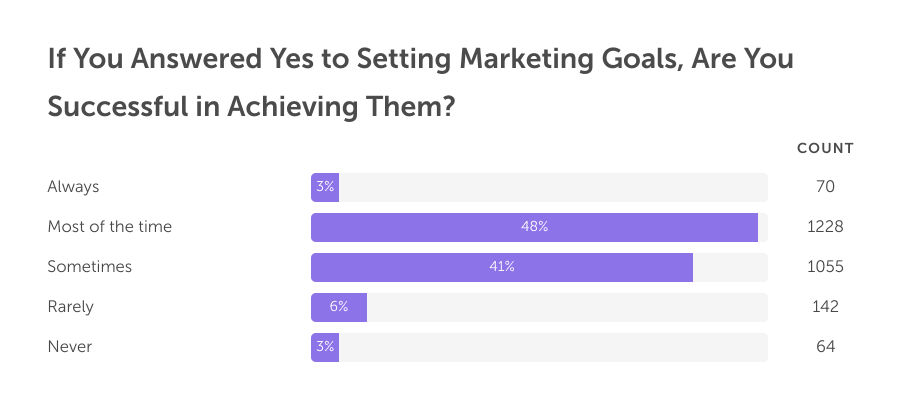
According to research from CoSchedule, marketers are 376% more likely to report marketing success if they set goals with just 6% of marketers who set goals saying they rarely achieve them and 3% never.
This still leaves 41% of marketers setting goals that only “sometimes” achieve them and there are a lot of factors that can contribute to this: not setting goals properly, failing to attribute success/failure, lack of or poor testing and optimisation, compromised data and a range of other variables.
Still, 48% of marketers who set goals say they achieve them “most of the time” and an elite 3% say they “always” hit their targets.
Goals vs objectives & metrics vs KPIs
Terms like goals and objectives are often used interchangeably but it’s important to understand the difference between them. The same thing applies to metrics and KPIs when it comes to measuring the effectiveness of your campaigns.
- A marketing goal is a broad, long-term result you want to achieve, such as increasing revenue, reducing customer churn, increasing engagement by 40%, etc.
- A marketing objective defines the specific, measurable actions marketers must complete to achieve specific goals. For example, if your goal is to reduce customer churn, one objective might be to increase email open rates by 30+%.
You’ll find similar explanations to the one above in this Goals vs Objectives: The Simple Breakdown article by HubSpot and this Smart Insights article, The difference between marketing objectives and marketing goals?.
So marketing goals are the top-level achievements you’re striving for with your marketing strategies while each strategy and campaign consists of several objectives that collectively help you achieve your goals.
For example, if your goal is to increase leads by 20+% throughout the course of this year, you’re going to implement new strategies for SEO, social media, paid advertising, email marketing and any other channels you consider valuable.
Each of these strategies could consist of multiple campaigns, each with several objectives, such as responding to all social media posts within one hour, publishing 4+ original posts on each network per day and increasing traffic from Facebook by 125%.
None of these objectives directly achieves your marketing goal but they all contribute towards and you know that falling short on objectives will make it difficult to achieve your goals. Why? because you’ve calculated that you need to increase Facebook traffic by 125% to increase on-site lead conversions by 20%, based on your current conversion rates.
- Marketing KPIs or (key performance indicators) are measurable outcomes used to determine goal or objective completion.
- Marketing metrics are specific data points for any measurable action.
Where things get a little confusing is the overlap between KPIs and metrics. Basically, every KPI is a metric but not every metric is a KPI and the easiest way to understand this is by looking at some examples.
The distinguishing factor of KPIs is that they’re measurable outcomes that you can use to determine whether goals or objectives are being achieved. For example, if your goal is to increase profit by 80%, then your primary KPI is profit – nice and simple.
As long as your goals are specific, it should be this easy to determine your KPIs. Vague goals like improve the quality of leads are no good to you – what does “value” mean, how do you measure it and what’s your target here?
However, if you set a more specific goal – let’s say, increasing the average value (net profit) of customers’ first purchases by 15% while maintaining ROI, the goal basically defines the KPIs for you: purchase value, net profit, ROI, etc.
Examples of marketing goals
Marketing goals can be ambitious enough to transform your entire business or relatively modest with the simple aim of creating more effective marketing processes.
However, all marketing goals should be specific, achievable and measurable – no matter how grand or small.
Let’s explore the following examples:
- Increase conversion rates by 150%
- Reduce customer churn by 5%
- Increase premium sign-ups by 50% year-on-year
- Increase brand / product awareness
- Increase traffic
As you can see, most of these goals set specific targets, which is something you should strive for every time you set out a marketing goal or objective. In the case of increasing brand or product awareness, there are no direct metrics for measuring this so you have to define your standards of measurements before you can put specific numbers on them.
We’ll explain this in more detail as we explore each of these examples and, finally, look at why increasing web traffic is not a suitable marketing goal.
Marketing goal: Increase conversion rates by 150%
Let’s say your current conversion rate across all channels (organic search, paid search, social, email, etc.) is 1.4%, which is significantly lower than the commonly accepted average across all industries of 2%-2.5%.
Understandably, you might want to improve this figure and a perfectly acceptable marketing goal to set would be increasing conversion rates by 150% by the end of Q4 2021, which would see you reach an average conversion rate of 3.5% across all channels.
Marketing goal: Reduce customer churn by 5%
The best marketing goals are data-driven so let’s imagine your company’s business analytics team comes back and says that customer retention is the biggest driver of revenue, which happens to be one of the insights from this KPMG study on customer experience.
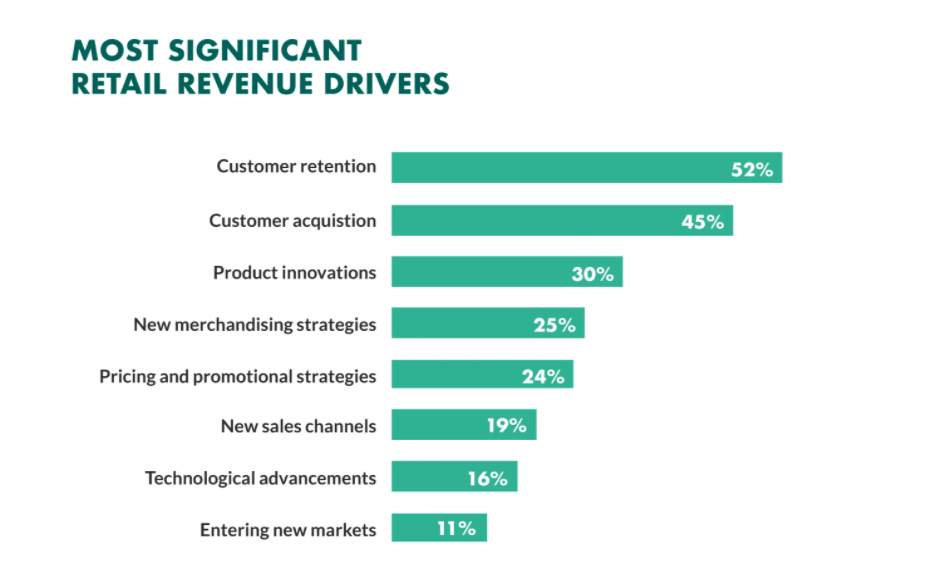
There are two statistics on this topic that have always stuck with me – first, that attracting new customers cost 5X more than retaining existing ones and that a 5% increase in customer retention results in 25%-95% increase in profits.
Now, those are old statistics in 2021 and they are only statistics but this doesn’t mean you can’t set the goal of reducing customer churn by 5% to see what impact this has on your business.
Marketing goal: Increase premium sign-ups by 50% year-on-year
SaaS companies typically adopt freemium models, tiered payment plans or a combination of the two. In either case, the money comes from paid users and customers paying for more expensive plans generate the most revenue – so increasing premium sign-ups is an important, ongoing goal.
This article from Business of Apps compiles data from several audiences to illustrate the growth of paid Slack users between 2014-2019.
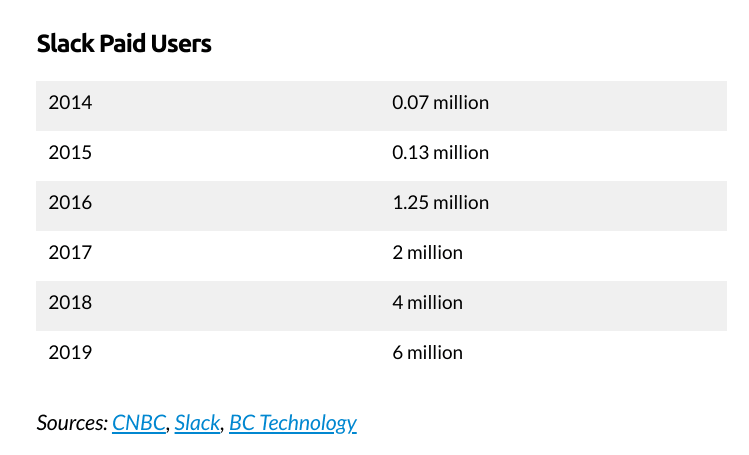
This tells us that Slack achieved the following growth rates for paid users in each of the years listed:
- 2015: +85.7%
- 2016: +861.5%
- 2017: +60%
- 2018: +100%
- 2019: +50%
That’s a remarkable average of +231.44% YoY growth (paid users only) over the span of five years from one of the world’s biggest SaaS success stories. This also illustrates how much growth rates can vary from one year to the next, even for the most successful software companies, and how much targets can change.
Of course, this is one of the most important marketing goals for any SaaS company and your targets influence every aspect of your strategy – from how much budget you invest to which channels and marketing strategies you employ.
Marketing goal: Increase brand / product awareness
Now, this is a tricky (but perfectly valid) marketing goal because awareness is difficult to measure. As a result, you can’t really set a goal like increase brand awareness by [insert figure] and expect to get conclusive, measurable results.
Before you can set this as a specific, measurable and achievable goal, you need to determine how you’re going to track awareness.
For example, you might set up some social media monitoring tools to check for mentions of your brand or product. You could also run periodic keyword reports to see how many people are searching for your brand or product on Google.
Meanwhile, social media engagement and traffic from branded or product search queries are less definitive, but still valuable, measurements.
Once you’ve decided which metrics you’re going to use to measure awareness, you can start to specify targets in your marketing goal – e.g.: increase monthly brand mentions on Facebook by 1,500%, monthly brand searches on Google by 500% and traffic from brand keywords by 350%.
Increasing traffic is not a marketing goal
This is one of the most common “goals” in digital marketing but it’s certainly not specific. In fact, I would argue this is a marketing objective, not a goal, because few (if any businesses) monetise traffic without visitors completing some kind of action.
The question is why do you want to increase traffic?
If you’re an online publisher, you may want to increase traffic to increase ad impressions and, therefore, ad revenue. So, in this case, increasing ad revenue is the goal while increasing ad impressions and traffic are marketing objectives. Likewise, the KPI will also be ad revenue while ad impressions and traffic are metrics.
Meanwhile, an online retailer might want to increase traffic based on the principle that, at their current conversion rate, more visitors will result in more sales. Again, the real goal here is to increase sales and traffic is a marketing objective that will help them achieve this, as long as other objectives are met, such as maintaining current conversion rates, profit per sale, etc.
Traffic itself doesn’t pay the bills and it’s no good bringing in more visitors if they don’t buy anything.
How to set your marketing goals
Hopefully, the points we’ve already covered give you a good idea of how to set effective marketing goals. As mentioned many times already, they must be specific, achievable and measurable if you want to hit targets and attribute success (and failures) to every marketing action, which is crucial for understanding what does/doesn’t work.
Luckily, there’s a tried and tested framework for creating effective marketing goals and there’s a good chance you’re familiar with this acronym.
- Specific
- Measurable
- Achievable
- Relevant
- Time-bound
Yes, the SMART goal framework is one of the most established concepts in business planning and, while I would love to suggest something more original, this is still the best formula there is for setting marketing goals.
We’ve already mentioned the first three characteristics of SMART goals: specific, measurable and achievable.
To be honest, the relevance aspect always sounds a little vague to me (but, hey, SMART goals sound better than SMAT goals, right?) but my interpretation of this is that your marketing goals must always be in line with the company’s business goals and contribute towards achieving them in both meaningful and measurable ways.
Finally, we’ve got the time-bound element of SMART goals and there’s nothing vague about this. You have to put a fixed deadline on marketing goals and success is only counted when you hit your targets within the specified time frame.
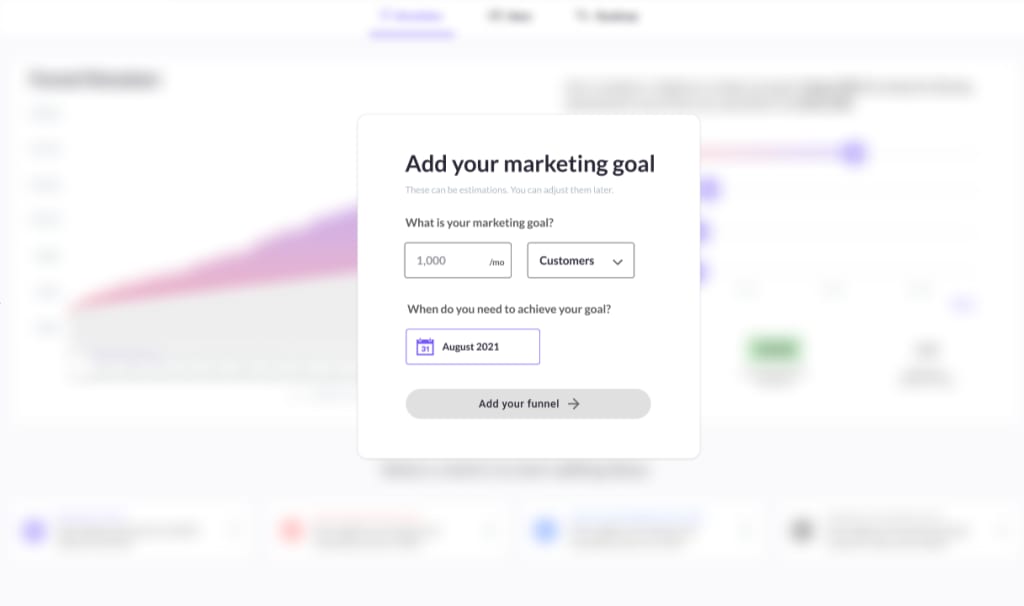
So all of the marketing examples we looked at earlier satisfy the SMART marketing goals framework. The first example we looked at was increasing conversion rates by 150%, on average, across all marketing channels by the end of Q4 2021.
Here’s how that stacks up against the SMART framework:
- Specific: Increase avg. conversion rates by 150% across all channels, from 1.4% to 3.5%.
- Measurable: The sum of avg. conversion rates across all channels divided by the total number of channels.
- Achievable: The target of 150% has been set based on current conversion rates, available resources and forecasting.
- Relevant: Conversion lift increases total revenue for 2021 and even more so for following years.
- Time-bound: Target must be achieved by end of Q4 2020.
If any of your goals can’t satisfy these five criteria, you need to work on them more. In fact, a good marketing goal should easily meet these basic essentials and, if you’re struggling to define any of these characteristics, that’s a definite red flag.
Are you being ambitious enough?
The SMART framework isn’t infallible, either. Let’s face it, anyone can set achievable marketing goals with modest targets and hit a 100% success rate but this isn’t going to maximise growth.
Your goals need to be both ambitious and achievable, which has led some to alter the A and R aspects of SMART to stand for Ambitious and Realistic.
Either way, you want to find the right balance between setting the most ambitious marketing goals you can while achieving a success rate that helps maximise the growth targets of your company.
In many cases, it’s better to fall just shy of ambitious targets if this means you’re really pushing to maximise performance – certainly better than underachieving by setting overly modest marketing goals.
Better yet, you can strive to set ambitious and achievable marketing goals by forecasting results before you even launch campaigns.
Forecast results to set ambitious, achievable targets
Setting targets for your marketing goals can be tricky. You don’t want to set the bar for success too low and risk underachieving or underselling your value to board members but you also don’t want your success rate to suffer and suggest you’re incapable of achieving results.
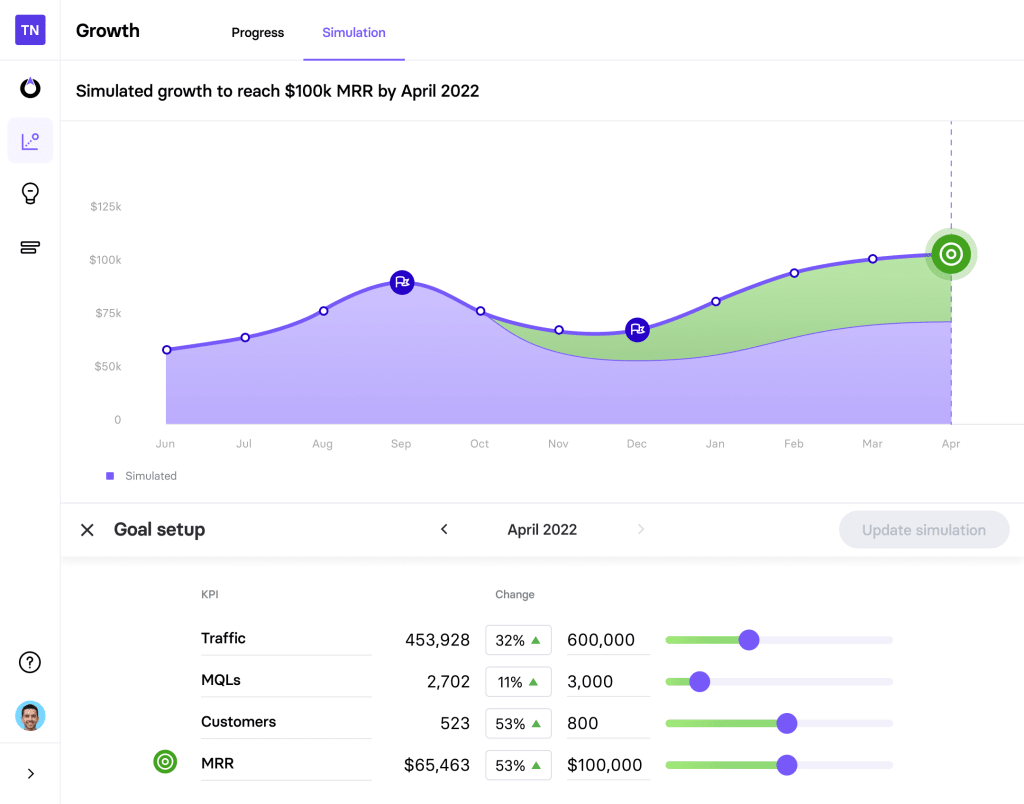
We use a platform called TrueNorth to simulate the results of different campaign ideas, allowing us to set the highest, achievable targets that are realistically achievable, based on our current results and resources.
This allows us to maximise ambition without letting our success rates suffer.
These simulations also allow us to create several campaign ideas for the same marketing goal and forecast the results to prioritise the campaigns expected to generate the best results for us.
With campaigns running, we can then track performance within TrueNorth to see where campaigns are hitting targets, performing better than expected or underachieving.
At this point, we can either run with the campaigns that are on course to complete our goals and pause the underperformers or optimise campaigns that aren’t getting the results we want to bring them up to pace.
This data provides valuable insights into which strategies, channels and campaign ideas are most effective for specific types of marketing goals, which we can then use to inform future goals and strategies.
Section #2: Marketing SWOT analysis
Yes, we’ve got another acronym here and, I promise, this is the last one but it deserves a place in this article. This time, we’re looking at the strengths and weaknesses of your marketing setup and the challenges you’ll face while implementing each strategy.
What is SWOT analysis?
In the words of CoSchedule, “SWOT analysis helps you understand the internal and external factors that can make or break your success towards your marketing goal”.
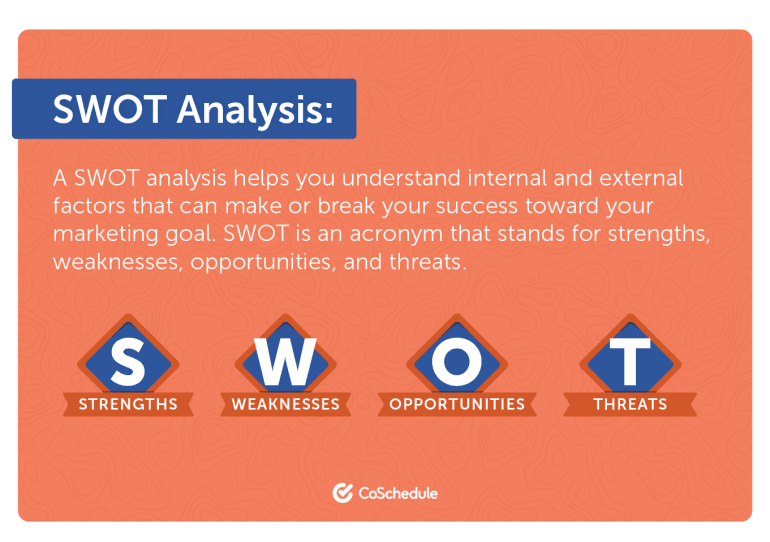
Strengths and weaknesses refer to the internal characteristics of your marketing team, resources and marketing processes. Then you have the external factors, starting with opportunities and the threats that could stand in your way of achieving your marketing goals.

- Strengths
- Weaknesses
- Opportunities
- Threats
You should run this analysis for every marketing goal you define and do the same for every campaign to address any unique strengths, weaknesses, opportunities and threats at the campaign level.
Identify your strengths
First up, you want to identify the strengths of your marketing team, resources and marketing processes, based on historical performance data. This includes anything relevant that your team does well, specialist skills you have on board, campaign types that tend to perform well or assets that will help you achieve your marketing goal.
Earlier, we look at a marketing goal example of reducing customer churn by 5%. So, in this case, our imaginary SaaS company might address the following strengths in their favour:
- Extensive online support documentation
- Free users remain highly engaged after 12 months
- High percentage of free users upgrade to paid plans
- High percentage of customer support queries settled
- Chatbot effectively settles basic technical problems
- Integrated marketing and sales team
- Effective upselling strategies encourage paid users to upgrade to more expensive plans
With these strengths, a SaaS company has some good fundamentals in place for converting free users into paid customers and some decent attributes for customer retention, too – such as its online documentation and chatbot which help users solve basic technical problems without support staff needing to get involved.
Identify your weaknesses
This is where you have to be brutally honest with yourself and identify the internal weaknesses of your marketing team and processes. For the sake of example, let’s list the following weaknesses for our imaginary SaaS company:
- A significant percentage of paid users drop back down to the free plan after upgrading
- Engagement on paid plans often drops 9-10 months after upgrading
- Low email open rate on customer retention campaigns
- Lack of qualitative feedback from users
- Support team overwhelmed during peak times
- Delays in support cases being picked up when they’re reassigned
- Limited session data makes it difficult to identify the causes of churn
By listing these weaknesses, we can already see some potential opportunities for reducing churn rates. Above all, we want to find out why users are dropping back down to the free plan and why engagement on paid plans often drops 9-10 months after upgrading.
This is going to be difficult, considering that another weakness listed is limited session data making it harder to diagnose the causes of churn.
So, right away, we can see that improving data capture and processing will help this company solve major problems. Of course, it will take time to implement new data systems and capture enough data to extract meaningful insights but the company could test strategies for keeping paid users signed up and maintaining engagement past the 10-month mark.
For example, they can try rolling out new features every nine months, asking users to sign up for beta testing after six months, gamifying the experience or incentivising engagement in some way.
The low open rates on retention email campaigns is clearly an issue that needs addressing, too.
Identify your opportunities
Hopefully, listing out your opportunities is going to be the most time-consuming part of SWOT analysis and you should already have some good ideas from analysing your strengths and weaknesses.
Rather than list a bunch of hypothetical opportunities for our SaaS company, it might be more helpful to focus on the different types of opportunities they should explore to reduce customer churn.
- Making better use of your strengths – e.g.: directing users to online documentation from inside your app.
- Overcoming your weaknesses – e.g.: shortening the delay of cases being picked up after they’re reassigned.
- Identifying market opportunities – e.g.: growing demand for certain features.
- Audience opportunities – e.g.: targeting prospects who are more likely to keep using your software product for the duration.
- New data opportunities – e.g.: implementing an in-app feedback system to gain insights directly from users.
- Product opportunities – e.g.: new features, updates, bug fixes, redesigns, etc.
- Customer support opportunities – e.g.: Prioritising cases that are most likely to result in churn.
- Process improvement opportunities – e.g.: Automating support and retention processes to free up more time and reduce delays further.
Obviously, a different marketing goal would result in a very different list of opportunities here. For example, if the goal was to increase lead generation by 100+%, then we would be looking at lead gen opportunities across organic search, paid advertising, social and every other relevant channel.
In this case, though, we’re focusing our efforts on the very latter stages of the sales funnel and lead generation isn’t our priority.
That said, it’s worth keeping in mind that refining targeting and messaging to capture leads from users who are more likely to keep using the software product (e.g.: businesses more than 5 years old) can improve results when it comes to customer retention.
At the end of the day, capturing the right kind of leads during the early stages of the buying process puts you in the best possible position to maximise lifetime customer value.
Identify your threats
The final step of SWOT analysis is to determine the external threats that could stand in the way of you achieving your marketing goals. So our SaaS company might draw up a list of threats along the lines of:
- Plenty of competition to tempt customers away
- Large competitors with bigger budgets
- Competition driving software prices down
- Industry innovation demands regular rollout of new features
- 5-8 rivals ranking higher in search for primary keywords
- Many customers affected by Covid-19 and lockdowns
When analysing SWOT threats, the strengths of your competitors are almost certainly going to be a key theme – especially the larger rivals with more resources at their disposal.
You also have to consider industry factors, such as how much demand there is for new features or where the bar is set for acceptable and positive user experiences.
During economic downturns or, say, global pandemics, you may also find a portion of your customers are affected by financial difficulties or other challenges that impact retention, lead generation and other key marketing goals.
Section #3: Buyer personas & audience research
Audience research should be the primary influence behind all of your marketing activities. In order to achieve your marketing goals, you need to align them with the needs and interests of your target audiences – otherwise, you’re not giving them any incentive to take the action.
At the very least, you need to identify your target audiences at every stage of the marketing funnel: who is each lead generation strategy targeting, which prospects count as marketing qualified leads (MQLs), which prospects are most likely to buy into your most expensive products or services?
You also want to draw up a list of buyer personas where you define the characteristics of your ideal customers.
For B2B companies, the traditional approach to audience research and buyer personas has been adapted into something called account-based marketing (ABM) where you target specific individuals at the companies you want to call customers – and we’ll look at this in more detail shortly.
Define your target audiences
Target audiences are the groups of people who can help you achieve your goals at every stage of the marketing and sales funnel. As prospects progress along your funnel, these audiences become more specific.
For example, your SEO strategy might target anyone with an interest in marketing automation software while your paid advertising and email marketing strategies prioritise large business owners with $50,000+ annual software budget to work with.
By defining your target audiences at each stage of the buying process, you can optimise campaigns more effectively to satisfy the changing needs of potential customers as they work their way along the funnel – e.g.: from the research stage into the consideration, comparison and purchase stages.
Build your buyer personas
Buyer personas are detailed profiles of your ideal customers, complete with all of the information that’s important to your company. This normally includes budget, needs and interests, background, the industry they work in (B2B), relevant behaviour, purchase history and anything else that tells you this is the person you want on your list of customers.
“Buyer personas are semi-fictional representations of your ideal customers based on data and research. They help you focus your time on qualified prospects, guide product development to suit the needs of your target customers, and align all work across your organization (from marketing to sales to service).”
How to Create Detailed Buyer Personas for Your Business by Pamela Vaughan for HubSpot
These buyer personas help you target your ideal customers, identify which prospects are most valuable and prioritise your marketing strategies to maximise returns from your most rewarding customers.
Account-based marketing
For the modern B2B business, drawing up fictional buyer personas and creating inbound marketing strategies designed to capture them as leads isn’t always the most effective way to win the customers you need.
Sometimes, you’re better off approaching the real-world businesses you want on your customer list directly and this is the key principle behind account-based marketing (ABM).
As we’ve explained before, “account-based marketing is a strategy that revolves around prospecting target companies (accounts) and creating campaigns designed specifically to capture them as leads and, ultimately, turn them into customers.”
To create a successful account-based marketing strategy, you still need to draw up your target audiences and buyer personas – the difference is in how you use them.
Here are some key characteristics of an effective ABM strategy:
- Accurate customer profiling, typically using your existing customer data and available third-party data.
- Data-driven prospecting to ensure you identify valuable and relevant accounts for your campaigns.
- Prioritising high-value accounts in order to maximise ROI.
- Personalising campaigns and content to address the unique needs of each target account.
- Aligning sales and marketing activities to ensure prospects navigate the entire sales funnel.
- Automating marketing and sales processes so you can handle more leads while both teams focus their efforts on tasks that can’t be automated.
- Integration with traditional inbound marketing to capture leads that your ABM strategy misses – and vice versa.
With your buyer personas defined in detail, you can then start to find companies that match your criteria and then identify the decision-makers at those companies who have the authority to sign off purchases.
To find these contacts, you’re going to need some specialist ABM and prospecting tools. We’ve drawn up a list of our favourite options in our article, 10 Account-Based Marketing Tools to Improve Your ABM Performance:
- DiscoverOrg: Enterprise B2B intelligence to power your ABM strategy.
- Terminus: A complete ABM marketing platform for prospecting and delivering multichannel campaigns.
- Triblio: A flexible ABM platform for medium-sized businesses.
- Vainu: Powerful, easy-to-use prospecting tool for SMEs.
- Leadiro: Affordable, scalable B2B data platform for smaller businesses using ABM as a growth strategy.
- AdDaptive Intelligence: Simple, powerful ABM list building software.
- RollWorks: Cost-effective prospecting and targeting for your ABM advertising campaigns.
- Madison Logic: Award-winning ABM software for powering your multichannel campaigns.
- Leadfeeder: A budget tool for identifying which companies visit your website.
- HubSpot: The all-in-one marketing, sales & ABM solution.
You can find out more about each of those tools and why they make our top 10 list of recommendations by clicking through to the main article here.
Other audience research tools
Aside from the ABM and prospecting tools listed above, you also want to compile a set of audience research tools to gain key insights into your target audiences.
Here are some recommendations to get you started:
- LinkedIn: The professional’s social network is an excellent audience research tool for B2B companies.
- Facebook: The platform’s Audience Insights tool is invaluable and you can also scrape all kinds of useful data from the network itself.
- Quora: A great place to put questions directly to your target audiences or find out which questions they’re asking others.
- Reddit: Another forum where you can pitch questions to people with relevant interests and discover their needs.
- Specialist forums: Niche public forums filled with your target audiences – e.g.: a video editing software provider might use DPReview, the official Adobe Premiere Pro forum and the forums of each major equipment manufacturer (Nikon, Canon, Apple, etc.)
- Feedback tools: Tools that help you capture feedback from your leads and customers directly.
- Third-party data sources: Industry reports, government data, open-source datasets, etc.
Of course, your list of audience research tools will vary depending on the nature of your business and who your ideal customers are. However, with the possible exception of LinkedIn, all of the tools listed above are valuable all-rounders that should give you enough momentum to get things moving.
For a more in-depth look at audience research, take a look at our article, Target Audience: The Art & Science of Finding Your Ideal Buyers.
Section #4: Competitive analysis
Competitive analysis is where you identify who your competitors are, identify their strengths and weaknesses, and weigh them up against your own business.
There are three key steps to this:
- Step #1: Identify your competitors
- Step #2: Analyse the competition
- Step #3: Update your SWOT analysis
Once again, competitive analysis is something you want to do at two levels: first, a thorough analysis for your business vs your competitors and, then, once again for every approved campaign – so that you can address any unique factors at the campaign level.
Step #1: Identify & analyse your competitors
The easiest way to identify your competitors is to type in your primary keywords and draw up a list of the rivals ranking in and around you in the SERPs – as well as any paid ads that show for your primary keywords.
First of all, this gives you a good idea of who your business rivals are in general but it also tells you who you’re competing against in search.
You’ll often find that some of the companies ranking above (or in and around you) in search aren’t direct business rivals but they are competing against you for certain keywords.
For example, let’s say you offer training management software specifically for training service providers, whose clients outsource employee training, rather than do it in-house. Now, one of your primary keywords is going to be “training management software” and many of your rivals will be selling a similar product. However, you’ll also find software products designed for the end business that wants to train their own employees in-house.
Here, we have two completely different products ranking for the same keyword and companies that aren’t direct business rivals competing in search for the same keyword.
This is an important distinction: you’ve got business rivals and, then, you’ve got search rivals.
What counts as a direct business rival depends on who your target audiences are and the specifics of your products or service. For example, you may be targeting small businesses only, in which case companies selling a similar product but targeting enterprise companies aren’t direct business rivals.
However, if you’re a software company that sells a scalable product for small, medium, large and growing businesses, then you are competing against rivals at every level.
A direct business rival is targeting the same audiences you are with a comparable product – and there are several factors to consider:
- Business size
- Industry
- Budget
- Location
- Implementation (cloud, on-premise, etc.)
It’s important to be as specific as possible so that you can pinpoint the businesses that really are competing for the same potential customers as you.
This doesn’t mean you forget about the more indirect rivals because they are still fighting for the same ranking positions in search and visibility, in general, across all platforms.
What you don’t want to do is put a lot of effort into differentiating from a company that’s targeting a different audience in the first place.
Step #2: Analyse the competition
Personally, I like to start competitor analysis from an SEO and copywriting perspective, as I feel this gives you a rounded summary of your competitors, which you can build upon over time.
The first thing I do is draw up a list of primary keywords, create a new Google Sheets document containing multiple sheets, one for each keyword. Next, I type each keyword into Google and fill out the relevant sheet with the following info:
Business details
- Company name
- Competitor type: Direct, indirect, keyword, etc.
- Search ranking (position)
- Page URL
Brand positioning
- Target audiences: Business size, budget, etc.
- Price
- Key selling points (KSPs)
- KSP clarity: How clearly these KSPs are defined.
Weaknesses
- Weaknesses of the ranking page (e.g.: copy, UX issues, etc.)
- Product/service weaknesses: Price, missing features, poor reviews, etc.
- Support weaknesses: Lack of channels, support times, response times, etc.
- Marketing weaknesses: Low review scores, weak presence on certain channels, low ranking for certain keywords, etc.
Strengths
- Strengths of the ranking page
- Product/service strengths
- Support strengths
- Marketing strengths
This should be enough to get you started and you can edit or expand the criteria in any of these sections as your analysis matures.
Here’s a little snapshot of what this might look like for the top two ranking rivals I’m looking into:

The downside to this approach is that it involves a lot of manual work but the upside is that you can delve deeper than the basic reports in most competitor research tools. I find this crucial for creative, conceptual strategies like copywriting and content marketing where you really need to analyse page content, results pages and marketing strategies by eye.
For example, I like to compare the KSPs of the rivals ranking in the top 20 spots of my clients and colour code them based on which selling points are most commonly used (ie: less unique).
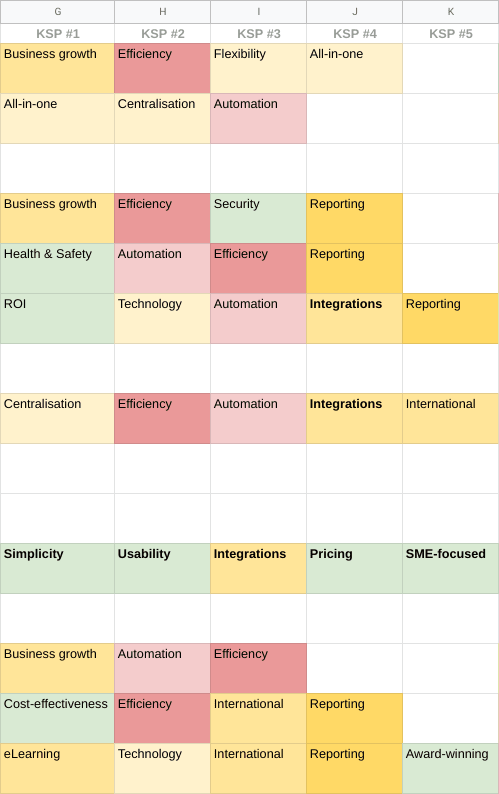
This helps me determine where the most common USPs are listed because they’re also the most important to the target audience and where there are opportunities to differentiate.
For example, in the screenshot above, efficiency and automation are most commonly listed KSPs but my client’s product doesn’t have the automation features to compete here.
In our audience research, we also spoke to my client’s existing customers and read through reviews for rival platforms and the complexity of similar products is the most common pain point that keeps popping up.
So, we decide to highlight the simplicity of onboarding, setup and customising the product with concepts of being able to start using the platform from day one and only paying for the features customers need while referencing the complexity of products and pricing models of other tools that normally geared towards larger businesses.
Step #3: Apply these findings to your SWOT analysis
Whatever approach you take to analysing your competitors, your findings will have an impact on the SWOT analysis you did earlier.
After weighing yourself up against the competition, you may have a different idea of what your strengths and weaknesses are but you should definitely have some new ideas about what your threats and opportunities are – especially the latter.
So go back to your SWOT analysis and update it to reflect the findings from your competitive analysis.
Section #5: Marketing & sales funnel analysis
For an in-depth look at marketing funnel analysis and strategies, take a look at our Marketing Funnel Strategies: 5 Steps to Increasing Sales article where we break down the entire customer journey.
The key to effective marketing across the entire funnel is understanding the customer journey each of your target audiences take.
Know the customer journeys of your buyer personas
As the illustration below shows, customers navigate a complex journey starting from the early research stage, all the way to making the first purchase and (hopefully) continued future purchases from your brand.
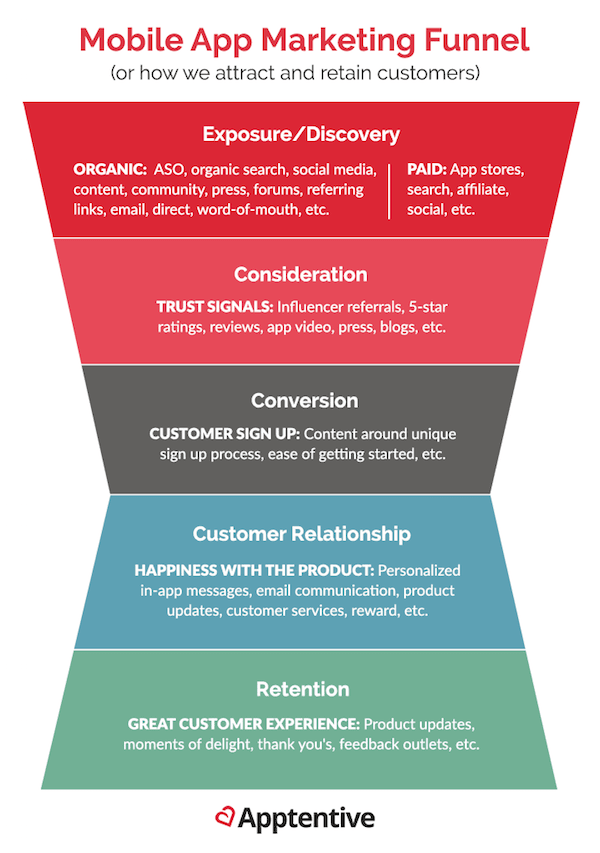
According to research carried out by Google, the average customer journey involves anywhere between 20-500+ touchpoints between a user’s first relevant search and completing the first purchase.
Of course, not all customer journeys start on Google, either. You might spark interest on LinkedIn, via Facebook display ads, guest posts on high-authority sites or offline channels.
You might reach out to target customers directly as part of your account-based marketing strategy, as we explored earlier.
Either way, you want to map out the customer journeys of your buyer personas and the touchpoints (ie: opportunities) where your marketing strategies can capture their interest.
As the Apptentive graphic above shows, the touchpoints vary as prospects navigate their way along the customer journey. For example, they might start with a top-level keyword like “productivity software” with a basic understanding that they need a product but no in-depth knowledge of which features they need or why.
So they might read a bunch of articles with titles like 10 Best Productivity Tools for Teams and like the sound of Serene, RescueTime and Trello.
Their next move might be to type in queries like “Serene app review” and see feedback like this on Producthunt.com:

Here, Marcus understands that Product Hunt is a key part of the early research stage (as well as customer support, feedback, branding, etc.) and engages with existing customers and free trial users who haven’t fully bought into the product yet.
After seeing some positive feedback, users might sign up for a free trial on the spot (nothing to lose, right?) or they might continue the research process and start comparing products to narrow down their options.
Let’s say they type in something like “Serene vs RescueTime” and see this article on Zapier’s website, The 7 best apps to help you focus and block distractions, featuring both products.
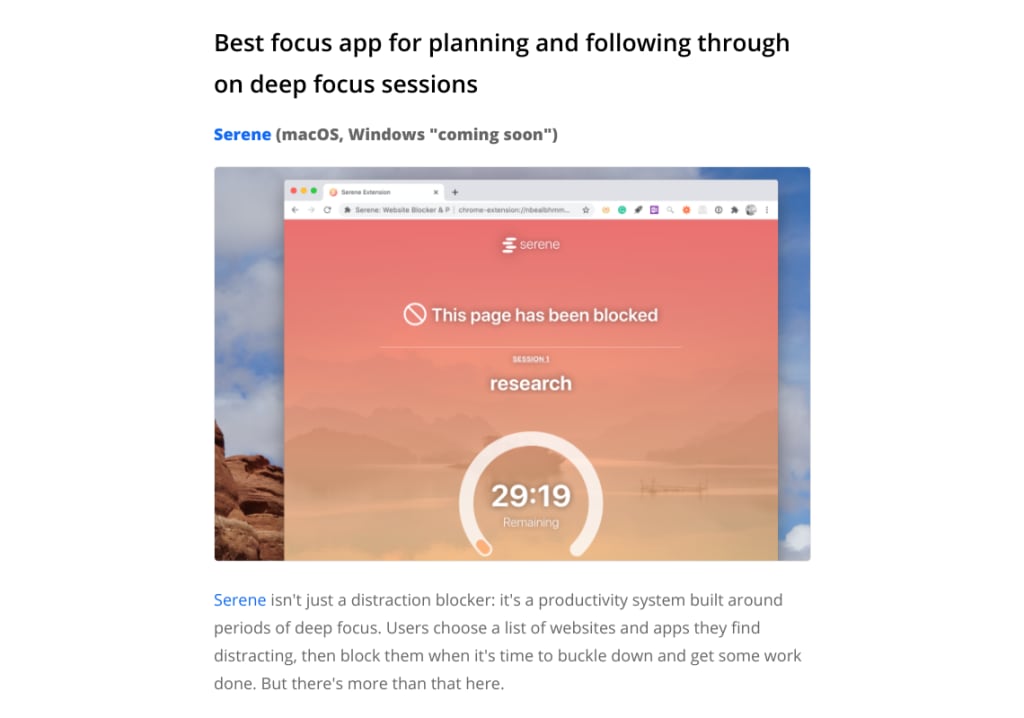
Not only does the article specify its interpretation of the product’s key selling point, it also highlights some of the ways you can integrate it with other tools using Zapier.
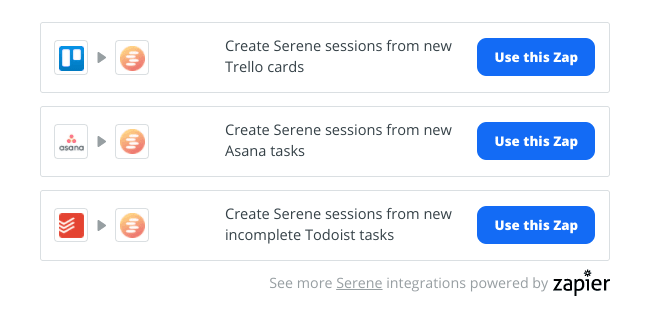
Towards the end of the article, we find RescueTime with a different KSP.
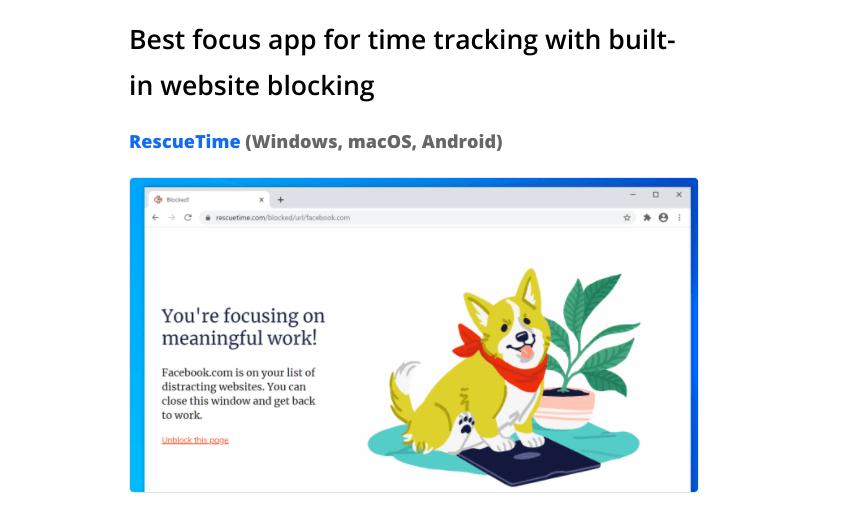
Interestingly, it also lists integration with Zapier’s Schedule app, which allows users to schedule daily focus sessions, which happens to be a key feature already built into Serene.

By now, we’re getting to a point where these touchpoints bring traffic to the Serene website and none of this happens by accident.
From the very beginning, we did our research on productivity tools, our target audiences and competitors to ensure we had a product worth promoting. We also identified key platforms like Product Hunt as a place to generate positive reviews for the inevitable “Serene app review” searches that our content marketing strategy is designed to generate.
We also identified Zapier as a key third-party target to get the app featured, not only on the companies blog but also its extensive list of integration options – something we developed into the Serene app itself.
By mapping out the customer journeys of our target customers, we were able to map out the ideal placements for our content marketing strategy to build a presence, positive feedback and recommendations from sources that send qualified traffic to the Serene website – users who are primed to sign up for the free trial.
Of course, this only accounts for the first conversion goal in our marketing funnel but the same principle applies throughout. And, once we’ve got users signed up, we have a direct channel of contact through their email address and user accounts.
Create lead generation strategies for every stage of the funnel
As we explored in the previous section, the key to funnel marketing is to understand how the interests and actions of your prospects change as they navigate through the customer journey.
Your mission is to generate leads at each stage of the funnel by delivering messages and/or offers that satisfy these needs.
This graphic from Samuel J. Woods’ article, Growth Funnel Hacks: Next Level Nurturing Through Segmentation, is a decent reflection of how your offers may vary for each stage of the marketing funnel.
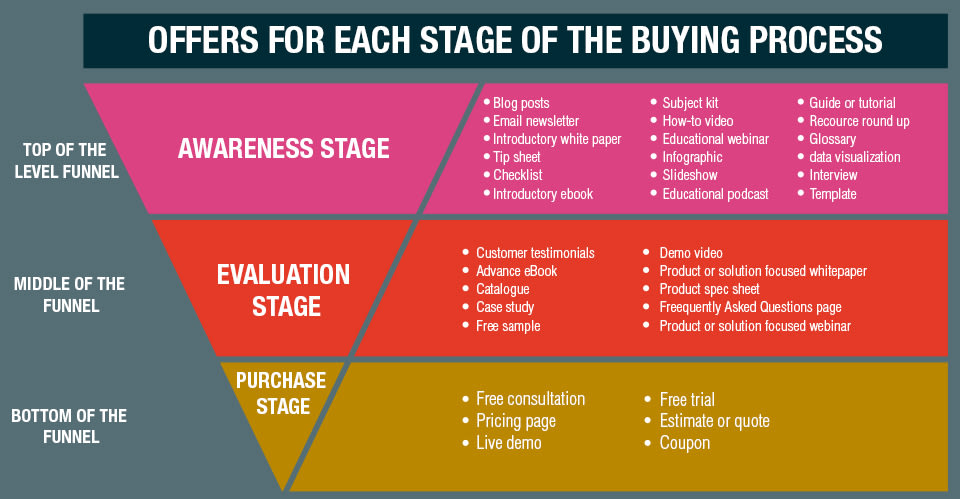
In the previous section, we looked at a number of content marketing strategies we’ve implemented to capture leads at the top and middle of the funnel for Serene.
So what happens when users actually land on the Serene website?
Well, we use CRO tools like heatmaps to analyse user behaviour and optimise the page to maximise conversions. We can also use Google Ads remarketing campaigns to target visitors who don’t convert with display ads to entice them back to the site. And, once users sign up for a free trial, they’re added to our lead nurturing email marketing lists, which we’ll explain in more detail in the next section.
The point is, we’ve got lead generation strategies in place for every stage of the marketing funnel, all based on the touchpoints we’ve mapped out in our customers’ journey analysis.
If you’re stuck for ideas on lead generation strategies, take a look at our 24+ Best B2B Lead Generation Strategies article and you might atlso want to have a read of our 35+ Lead Generation Tools To Boost Your Results to pinpoint the best tools for your marketing strategies.
Optimise your funnel & nurture leads
The thing with marketing funnels is they’re not watertight. Leads can slip through gaps, especially if you’re not attributing actions to individual leads effectively – something that’s especially challenging at the earlier stages of the funnel.
We’ve covered this topic before in our 5 Steps to Fixing a Leaky Marketing Funnel article, where we run through the following five key strategies:
- How to pinpoint your leaks
- Determine why you’re losing leads
- How to plug conversion killers
- Refining your lead nurturing strategy (to turn more leads into paying customers)
- Turning customers into repeat buyers
This covers every step of the marketing funnel so that you can address gaps and test fixes to reduce spillage.
Taking this a step further, you can use TrueNorth, to simulate how improvements in your funnel will impact your growth over time, allowing you to model different scenarios and increase the likelihood of achieving your marketing goals on time.
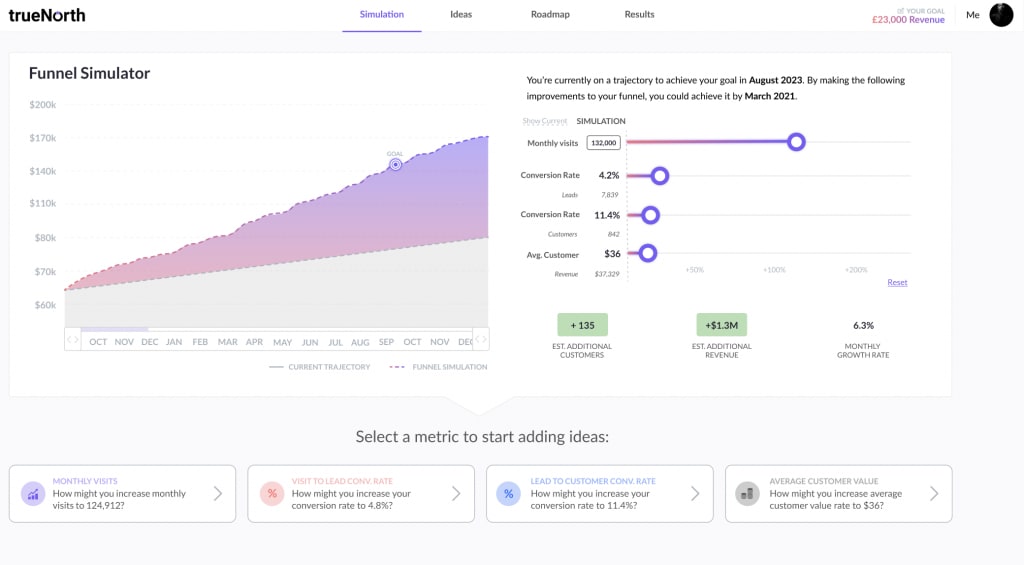
Lead generation is only one aspect of funnel optimisation and lead nurturing is where a lot of companies fall short. Generating leads is great but your marketing efforts aren’t going to achieve the best ROI until you’re turning as many of these leads into paying customers as possible.
We’ve also covered this in detail before in our How to Own the B2B Customer Journey article.
Here are the key lead nurturing techniques we cover in that article:
- Lead qualification: This is where you approve or reject leads to ensure you’re only using resources on prospects that are worth it.
- Lead scoring: Assigning a lead score to prospects, which allows you to prioritise leads and focus on the most valuable prospects to your business (scores will change as leads progress along the consumer journey).
- Lead segmentation: Creating groups and assigning leads to them based on shared interests so you can target them with relevant ads.
- List mapping: Assigning segmented lists to stages of the customer journey so you can create campaigns designed to move prospects onto further stages of the buying process.
- Campaign delivery: Choosing the right channels and targeting to deliver campaigns/messages to leads at the relevant stage of the customer journey.
The key to effective lead nurturing is to combine on-site tracking with email lead generation strategies, allowing you to assign behaviours to individual users.
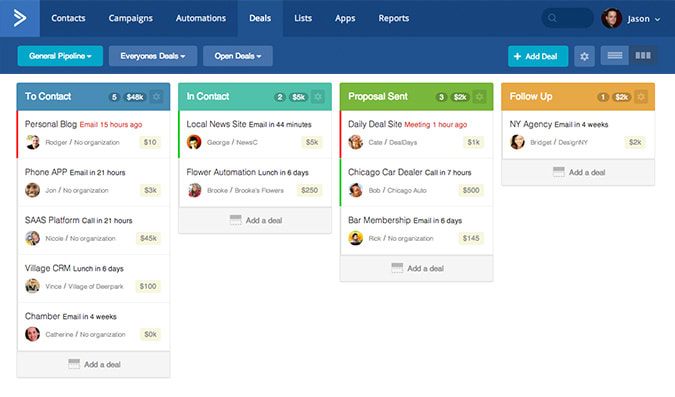
We use ActiveCampaign because it provides an all-in-one CRM, email marketing and marketing automation platform, allowing us to assign on-site actions to individual users. We can also automate lead nurturing email marketing campaigns to send relevant messages to prospects as they progress along the latter stages of the marketing funnel, putting us in the best position to convert them into paying customers.
As mentioned earlier, the initial purchase is not the end of the customer journey, though.
We want these people to keep using our products and, more importantly, happily keep paying for them as loyal customers. So, at the final stage of the funnel, our efforts focus on customer retention and here are some examples of the most common strategies to use here:
- Quality products/services: First of all, you need to make sure your products/services are good enough to keep customers on board – otherwise, this entire strategy is going to fail.
- Customer service: No matter how good your products/services are, customers are going to experience problems from time to time and how you deal with these is going to be a major factor in your retention rates.
- Upselling/cross-selling: Recommending related products that might interest your customers or encouraging them to commit to a more expensive purchase, longer-term commitment, etc.
- Customer feedback: Show your customers that you listen to them by asking them for feedback and actually implementing changes based on the info they give you.
- Rewards/loyalty schemes: Rewarding customers for their ongoing purchases makes them feel valued and encourages them to keep buying from you.
- User accounts: Customisable user accounts make it easier for customers to make repeated purchases, manage their orders and explore new purchase options.
- Customer reviews: You can’t please everyone or get things right all of the time but a large collection of positive customer reviews might show disgruntled customers that their unpleasant experience was a rare case and encourage them to give you another shot.
This is especially important for SaaS and B2B companies where repeat custom is a key component of the business model – as well as a lot of consumer brands who are constantly fighting against new competitors.
Section #6: Selecting the right marketing channels
Marketing success starts with getting your message seen by the right people, which means you need to choose the channels and platforms where your target audiences are active at each stage of the customer journey.
Now that you’ve analysed your marketing funnel, it’s a case of mapping out channels to each stage and, then, choosing the ideal platforms to reach your buyer personas every step of the way.
Know your marketing channels
The most important aspect of choosing marketing channels is understanding the role they play along each stage of the customer journey. So let’s quickly summarise how your target audiences interact with these channels in ways that produce marketing opportunities.
Organic search
Search engines are often the first place people turn to when purchase intent emerges. Search queries that demonstrate a strong purchase intent tend to trigger ads, which we’ll discuss in the next section, but organic search is where the vast majority of traffic – 53%, according to research from BrightEdge.
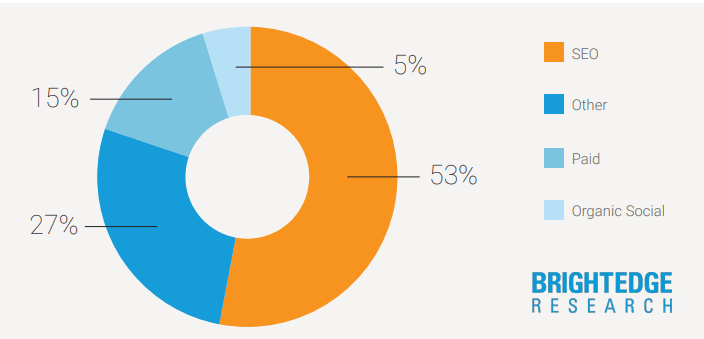
It’s also worth noting that separate studies show more than half of all Google searches are now zero-click searches, meaning they generate no traffic.
A lot of marketers talk about this like it’s some kind of a disaster for SEO but keep in mind that most zero-click searches are the ones that never involve any business opportunities to begin with – like “weather Tokyo”.

Purchase intent can’t be satisfied by answer boxes and rich results. These users are looking to click through to websites to find out information about potential purchases, read reviews, compare products, look at specifications lists – informational searches that help users to make informed purchase decisions.
This is the key role organic search plays in the customer journey and it’s most important during the earlier stages where prospects are researching purchase options. As they progress along the marketing funnel, the role of organic search tends to be less important (at least, from a lead generation perspective) but there are still opportunities to be had from certain touchpoints – such as brand searches.
Paid search
When searches get serious, Google and other search engines tend to cash in by showing ads for the majority of queries that demonstrate a strong purchase intent.
By this point, users have started to move out of the research stage and started weighing up serious purchase options, which is where you want your brand, product or service to be most visible.
Higher purchase intents make these keywords worth paying for but one of the key benefits of paid advertising on search engines is being able to target previous visitors with remarketing ads, allowing you to deliver messages after they leave your website.
Best of all, you’re not limited to targeting paid traffic with remarketing campaigns. You can also target organic visitors through Google Ads remarketing campaigns, providing a crucial channel for engaging organic website visitors at the top of the funnel.
Social media
Social media is a diverse channel of platforms, each one serving a different role to their respective user bases. Like search marketing, social media provides organic and paid opportunities but the opportunities they generate are very different to the kind you get from search engines.
Above all, people turn to search when they’re actively looking for something and they complete the physical act of typing in a search query, hitting the search button and clicking through to a website for more information.
On social media platforms, users are scrolling through their feeds and engaging with content handed to them by algorithms. They’re not looking for anything and your content or ads are being passively fed to them – so you don’t get the same kind of purchase intent search is so good at generating.
This means you’re generally catching leads at the earlier stages of the customer journey – before they even realise they have any purchase intent.
In terms of campaigns, social is generally most effective at the following:
- Building brand awareness
- Reaching a wider audience
- Sparking purchase intent in users who don’t realise they’re in the market for anything or tempting
- Revitalising purchase intent in people interested in your product/service when they’re not actively looking for it
So you’re mostly capturing leads at the earlier stages of the customer journey but the behavioural targeting options available on many platforms allows you to reach highly-specific audiences that demonstrate an interest in your product or service.
The other important thing to understand about social media as a channel is that each network has its own unique audience – so you’re working with a very different audience on LinkedIn than Facebook, for example, or Twitter than Instagram.
An intrinsic part of this audience diversity is the unique experience provided by each network and the most obvious example of this is the different content users engage with on each network.
Once again, the content and ad formats on LinkedIn differ greatly from those on a video network like YouTube and you have to be able to create the same kind of content your target audiences are engaging with on your networks of choice.
There’s not much point in choosing Instagram as a social channel if you’re not capable of producing video and image content that gains traction.
Website
For most marketers and businesses, the channel holding every strategy together is the website. This is where all of your inbound traffic arrives, allowing you to shape the post-click experience, deliver compelling messages and encourage users to complete your conversion goals.
Chances are, the first inbound strategy that comes to mind when you think of websites as a channel is the blog, which you could argue is a channel in itself – one that plays a fundamental role in content marketing (we’ll be talking more about this shortly).
There are plenty of other on-page strategies you can use to bring targeted traffic to your website, though:
- Landing pages: The destination for paid traffic and organic searches related to specific product ranges or service types.
- Product / service pages: Top-level product and service category pages (great for SEO) or individual pages for specific product or service searches.
- Free tools: We’ve talked before about hosting a free tool on your website to capture leads.
- Online documentation: Guides, how-tos and support documentation can help your existing customers but also attract the attention of people looking to learn about topics related to your product (e.g.: guides to holding presentations on a presentation software website).
- Chatbots, live chat, etc: A powerful customer service channel but also a lead generation opportunity for users who are converting through your CTAs.
- Popups: While controversial, tools like exit-intent pop-ups can capture leads from users who would otherwise leave your website.
For some businesses, the website is a channel that generates leads through email, phone calls and inquiries. For others, such as SaaS and e-commerce companies, almost the entire customer journey takes place on the website, normally through user accounts.
This opens up several other potential channels, including web apps and mobile apps where you can deliver personalised messages to users within your app or their account, such as notifications, prompts, incentives and feedback requests.
As far as marketing channels go, your website is almost certainly the most important – so be sure to take full advantage of it.
Referral content
Referral content is published on third-party sites or apps, linking back to your website as a referral traffic source. There are many types of referral content, and we’ll look at the most common examples in a moment, but there are three broad categories I want to specify, first:
- Controlled referral content: This is content you publish on third-party sites or have full control over (e.g.: guest blogs).
- Influenced referral content: This is where you strategically influence or encourage valuable sources to link to your website.
- Uncontrolled referral content: This is content that links to your website without any control or strategic influence from you – it just happens – and this could be a good or bad thing.
We’re going to focus on the first two types of referral content in the rest of this section but let me quickly talk about the third type. As your online presence grows, third-party sources will naturally link to your website and some of these links will be helpful while others won’t.
So keep a constant eye on your link profiles to remove any unwanted links and always remember to redirect links if you ever have to migrate your website for any reason – e.g.: moving from HTTP to HTTPS or converting to a multilingual website.
Now, let’s take some time to explore the most common controlled and influenced types of referral content strategies.
Outreach or guest blogging
Guest blogging is probably the first type of controlled referral content that comes to mind. This is where you target quality, relevant third-party websites where you can publish content and link back to your website.
Originally, this took off as a link building strategy but the era of blackhat SEO kind of ruined this strategy by forcing Google to clamp down on guest blogging in response to website owners and marketers paying for links.
Guest blogging still has a tarnished name but I prefer the term “outreach” anyway. Whatever you call it, this is still a viable (and valuable) strategy, especially since Google started looking at nofollow links as a hint for crawling and indexing.
Google’s key step in dealing with dodgy guest blogging was to penalise links that were clearly bought or irrelevant and encourage publishers to use nofollow links, which pass no SEO benefits. However, Google is now confident that its algorithm can determine when links deserve credit, even if they’re marked up as nofollow links.
So nofollow links are now beneficial but, even before this change, outreach was still a valuable strategy.
You may not have gotten the link juice that was once available but links still generate traffic and getting your content in front of relevant audiences on third-party sites is a great way to bring qualified traffic to your website. This is especially true when you get content published on relevant sites with a larger audience, allowing you to increase brand exposure and get your message seen by the masses.
Brand or product mentions
Brand mentions are a ranking factor in Google’s search algorithm and they also build brand awareness for you. When we launch a new product, we strategically encourage relevant target companies or figures to talk about our products in their own content.
Essentially, we’re getting industry influencers to write about us organically without reaching out to them guest blogging of influencer marketing opportunities. They choose to write about our products but we give them some gentle encouragement by giving them reason to talk about our products and, then, talking about them first to encourage reciprocal brand mentions.
In fact, we looked at an example of this earlier with an article published by Zapier that recommends Serene as one of the best productivity apps.

This was no accident. We built Zapier integration into the Serene app and published several pieces of content showing what users can achieve by integrating the two platforms.
We also recommend Zapier in many of our own blog posts and, crucially, the app deserves all of these mentions because it’s a quality tool. These recommendations are also relevant because we’re all about automation here at Venture Harbour and Zapier is, at its core, an automation app.
So all of this is very natural and Zapier knows we’re writing about them because, like all good SaaS companies, it’s tracking brand mentions. The company also understands that productivity is an important trend – one that inspired the very concept of Serene and informed all of the design choices and features built into the tool.
So we’ve given Zapier genuine reasons to talk about our product, namely by producing one of the best tools on the market. We’ve also alerted them to our presence by mentioning the company’s brand first and incentivised the reciprocal mention.
As a result, one blog post gets our newly-launched product seen by a large number of people while we work on building a search presence for Serene from scratch.
Affiliate marketing
Affiliate marketing is a classic strategy and we’ve looked at this in detail before:
- Affiliate Marketing Made Simple: A Step-By-Step Guide
- 10 Affiliate Marketing Strategies That Generated Us Over $1M in Income
The basic premise is that you pay a small commission to companies or individuals for recommending your product but you only pay them when their recommendation is attributed to a purchase.
As a result, this is an incredibly low-risk strategy that always pays for itself and it can be a powerful one, too, when implemented correctly. In fact, this is especially effective for software companies because digital products are difficult to test and compare.
The same is true for technology and consumer electronics or anything where people are buying technical products without necessarily understanding what all of the specs and features really mean for them.
Influencer marketing
We tend to think of social networks like Instagram and TikTok when it comes to influencer marketing but this is only one aspect of the strategy. It doesn’t matter what industry you’re in, or which marketing channels and platforms you use, there are influencers that help you encourage people to make purchase decisions.
Earlier, we looked at how we encouraged Zapier to write about our products and Zapier is a genuine influencer in the SaaS industry. Software buyers read its content and make purchase decisions based on its recommendations and integrations with other products.
Likewise, there are plenty of software reviewers on YouTube now who rate and recommend products – genuine social media influencers who are a far cry from the stereotype of beauty and travel influencers on Instagram.
So don’t mistake this as a strategy for flashy B2C companies. LinkedIn is a hub of business influencers, for example, and every industry leader could become a key figure in your own influencer strategy – whether it’s Zapier, Forbes or the latest tech influencers in your target countries.
Email marketing
Email marketing has stood the test of time like no other digital channel and its inherent strengths of being an owned platform that allows you to reach prospects on an individual basis are precisely why email is as relevant as ever.
In fact, email continues to get strongerc, thanks to automation technology, which allows you to manage the entire customer journey with little manual input.
Email marketing isn’t just a lead generation strategy, it’s also the definitive channel for lead nurturing. No other channel gives you a direct line to deliver targeted messages to prospects at every stage of the funnel, allowing you to convert leads into customers and inspire repeat/ongoing purchases to minimise churn and maximise customer value.
There are seven key stages to a complete email marketing strategy:
- Email capture: This is where you turn website visitors into email leads by capturing their email addresses via web forms – everything from newsletter subscriptions and free downloads to account sign-ups and purchases.
- Lead qualification & scoring: Filtering out irrelevant and low-quality leads to concentrate on high-quality prospects and scoring leads to prioritise your efforts on those expected to generate the strongest ROI.
- Lead nurturing: Guiding prospects along the buying process with targeted messages at each stage of the marketing funnel.
- Email conversions: Campaigns that convert leads into paying customers.
- Customer retention: Keeping customers engaged and turning them into repeat/ongoing buyers.
- Upselling & cross-selling: Encouraging customers to buy related (cross-selling) or more expensive (upselling) products.
- Re-engagement: Campaigns reaching out to customers that stop buying or engaging with your brand to bring them back on board.
That’s quite a list to work through and each of those email marketing goals requires a comprehensive strategy of its own. Thankfully, email marketing technology has advanced a lot over the past decade, empowering businesses of all sizes to manage comprehensive email marketing strategies that would otherwise require an entire army of marketers, designers and other experts.
Now, you can automate the majority of your email marketing strategy so that all of your time is invested in the creative aspects. Here at Venture Harbour, we’ve been using ActiveCampaign for the past five years as our all-in-one CRM, email marketing and marketing automation platform.
Here are some examples of the kind of campaigns we’ve automated with ActiveCampaign and the rest of the tools in our tech stack:
You’ll also find plenty of suggestions for email marketing tools in our email marketing tool guide article and marketing automation tools in this: 53 Business Automation Tools That Skyrocketed Our Growth by 330%.
Determine your core channels
As Marcus explains in our guide to marketing plans for agile marketers, “the best performing marketing teams tend to focus on one core channel at a time rather than trying to do a bit of everything.”
You’ll generally start by investing a small amount of budget across every channel identified in your strategy and then measure results to get an idea of which channels stand out as the most profitable place to invest the majority of your budget.
You then optimise this channel to maximise performance until you reach diminishing returns before slowly diversifying your channels and optimising to maximise performance, once again, until you’ve got an effective multichannel strategy at optimum performance across the board.
Here’s a summary of how this process works across three phases:
| Maturity | Description | Strategy | Budget allocation |
|---|---|---|---|
| Phase 1 | We haven’t found our one core marketing channel that drives exceptional results. | Invest a small amount of budget in a wide variety of channels to identify one channel that drives disproportionate results. | 100% on experimentation |
| Phase 2 | We have found our one core marketing channel that drives exceptional results. | Focus intensely on that one channel until you see diminishing returns. | ~90% on core channel ~10% on experimentation |
| Phase 3 | We have saturated our core marketing channel and are seeing diminishing returns | Slowly diversify your channels, adding one or two new channels that you can double down on, while strengthening your one core channel. | ~80% on core channel ~20% on experimentation |
You can find a more comprehensive breakdown of this process in Marcus’ guide to agile marketing planning where he looks at each stage in detail and then runs you through an example of how to determine your core channel.
Section #7: Ideation & campaign strategy
At this point, you’re ready to start putting campaign ideas together and, like every part of a marketing strategy, there are processes for this. Your first task is to create a constant flow of ideas within your marketing team, which requires a combination of solo and group creative sessions.
Build a culture of creativity
Creativity is a wonderful characteristic to have but a lot of marketers and teams are less creative than they would like to admit. The thing is, you have to build an environment where creativity can flourish and instal processes that nurture it because creativity is fickle – and, once you stifle it, it’s not always easy to call it back.
Building a culture of creativity is something you need to do from the very top of your marketing team. Or, better yet, from the top of your company or organisation.
For example, it’s no good asking team members to work and collaborate from home if you, then, pressure them to answer emails at every hour of the evening. Likewise, you can’t expect team members to voice their ideas if they’re worried they’ll get shut down for saying the wrong thing or suggesting something that doesn’t sound too smart.
The most innovative ideas push the boundaries of what’s known, accepted and already works so you need to build an environment where creativity is encouraged. Also, keep in mind that even the best ideas are really foolproof or complete when they’re first conceived; they tend to be scrutinised, worked and developed from potential into something special.
Here at Venture Harbour, we meet every week to discuss campaign ideas, optimisations and experiments. We brainstorm ideas individually ahead of meetings so that everyone has got something to contribute and this also allows us to scrutinise our own ideas a little before we suggest them in a meeting.
During meetings, we then put our ideas forward and analyse them together – what’s good about them, what might be wrong with them and whether there’s room to develop or improve them. As far as we’re concerned, there’s no such thing as a bad idea and we know from experiences that the most successful campaigns don’t always sound that great when the idea is first pitched – so there’s no anxiety or ego in these meetings.
Our aim is to leave each meeting with 10 or more ideas that we can add to our backlog. We’re not going to commit to all of these but we are going to scrutinise and develop these ideas further into stronger campaign creatives before we decide which ones to push ahead with.
Use data science to inform campaign & strategy ideas
It’s easy to say that all ideas are welcome but human beings come with built-in self esteems. Luckily, these are protected when campaign ideas are driven by data because nobody’s opinion is on the line. Data-driven ideas are guided by cold, hard numbers and you’re not going to hurt any metrics’ feelings by turning down a campaign idea.
More importantly, research shows time and again that data-driven marketing campaigns are more successful than those based on gut instinct or opinion.

As a result, you want a certain level of data literacy among everyone on your team and the right set of analytics, business intelligence (BI) and data visualisation tools to help team members gain meaningful insights from raw data.

Here at Venture Harbour, We use the Funnel Simulator in TrueNorth to inform campaign ideas. The tool constantly forecasts our chances of hitting our marketing goals and shows future trajectory based on current and historical performance.
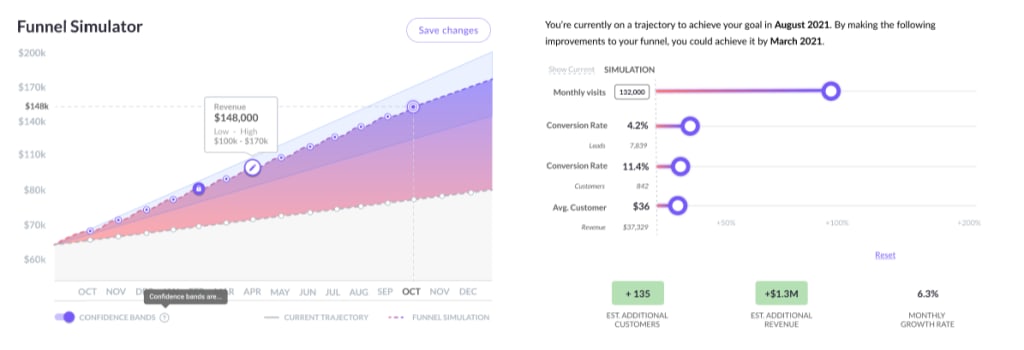
On the right-hand side of that dashboard, you can also see a set of key metrics that will help us achieve our goals sooner and drive faster growth.
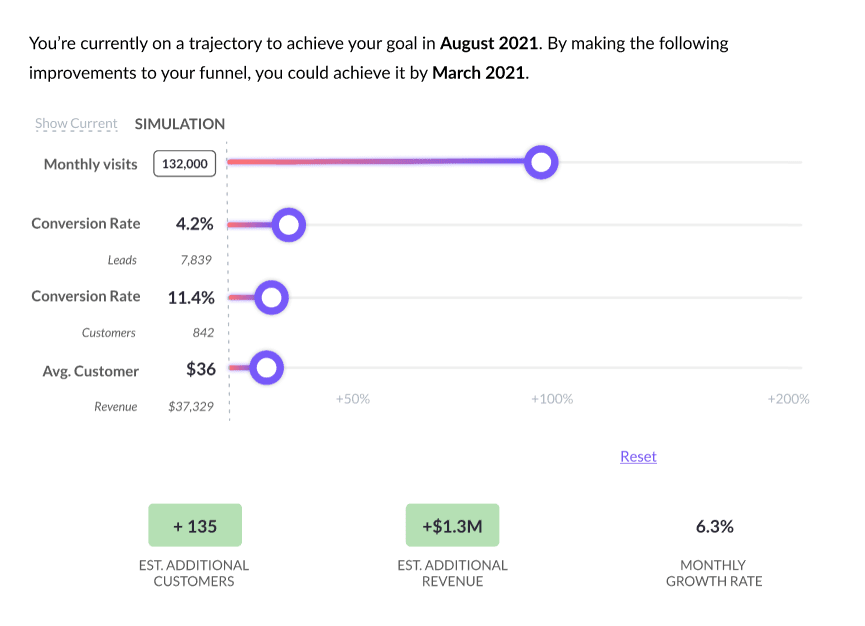
So, here we can see that our marketing goals are achievable by March 2021, as opposed to August, if we hit the achieve the following objectives:
- 132,000 monthly visits
- 4.2% lead conversion rate
- 11.4% customer conversion rate
- $36 average customer spend
This would put us on track for a 6.3% growth rate and +$1.3 million additional revenue for the year.
This gives us quantified targets and outcomes to aim for and our marketing team can sit down and put campaign ideas together that will help us achieve them. So we’re not just aimlessly trying to come up with “better” marketing campaigns; we’ve got concrete targets to inform every strategic process and the data is guiding every decision we make.
For example, we’re looking at this revenue target and saying we need to increase conversion rates by X, which means boosting traffic by Y and increasing our paid advertising budget by Z, based on current performance. And then we can look at optimisation strategies and experiments to increase conversion rates without upping our PPC bids to maximise ROI.
Prioritise campaigns
When our team has at least 10 campaign or experiment ideas, it’s time to calculate which of them are most promising so we can determine which ideas to press on with.
We analyse each idea using the ICE framework (Impact x Confidence x Ease) to prioritise campaign ideas based on the balance of expected impact and execution, as you can see below.
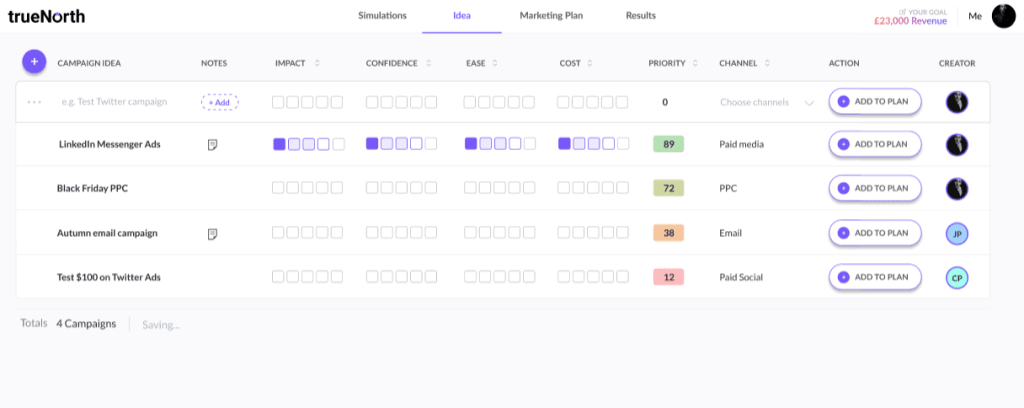
There’s no such thing as a perfect framework – they’re all compromises of efficiency – and there’s a crucial factor missing from the traditional ICE framework: cost.
Every campaign has a financial cost and there are other resource expenses that you need to consider, too, with time being the most obvious. So, if two campaigns are expected to increase revenue by 125% but one is going to cost half as much to hit that target, then you want to go for the more cost-effective options.
Likewise, if all else is equal, and one campaign is projected to hit targets in half the time, then you want to go for the more time-efficient option.
So we’ve added a Cost column into the campaign idea interface and I guess this means we’re using an ICE(C) adaptation of the traditional ICE framework.
- Impact: The projected impact and results of each campaign idea.
- Confidence: How confident we are of hitting the projected target.
- Ease: The relative ease of implementation (remember SWOT analysis).
- Cost: The projected cost of each campaign idea – namely the financial cost but you may include other “expenses”.
Whatever framework you use, the point of this exercise is to rank campaign ideas based on data, historical performance and projections to get the best idea of which campaigns to run with and how to prioritise them.
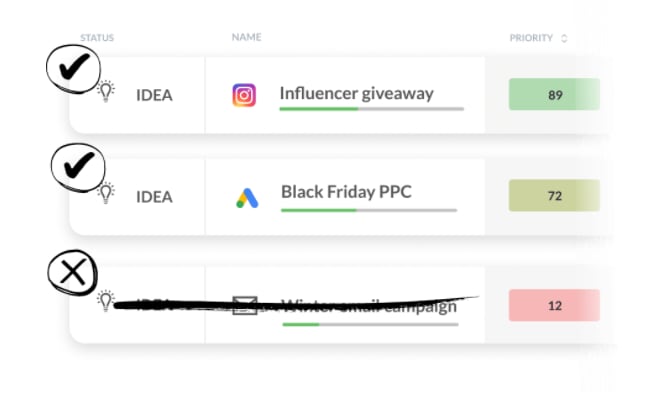
Once campaign ideas are approved and prioritised, they’re added to the marketing plan for our team to flesh out and analyse in greater detail. The score for each campaign can change at any time if, for example, we run into unforeseen challenges that will make it more difficult than predicted to hit the target of any given campaign.
The point is, we always have a list of prioritised campaigns and targets throughout the planning and execution processes, which carries over into campaign measurement and optimisation when campaigns go live.
Section #8: Defining metrics & KPIs
We’ve talked a lot about goals, objectives and data in this guide so far but all of this falls apart if you’re not tracking the right metrics and KPIs for every campaign.
Select the wrong data points and everything comes unstuck – your projections mean nothing, you can’t see where success and failure is happening and you certainly can’t react to anything with accuracy. Worse still, your reports are going to show false positives (and negatives, for that matter), which is a serious problem for performance-based marketing and business, in general.
Metrics vs KPIs
This might be a bit basic, but the first thing we need to specify is the difference between metrics and KPIs. If you see these terms being used interchangeably, they shouldn’t. And, if you’re not 100% clear on what the difference is between these two types of data, don’t scroll past this section.
What is a metric?
A metric is any data point that registers a specific action, events or performance measurement. At this point, it might help to look at some examples for each type of metric:
- Actions: These are specific actions the user takes, such as link clicks (CTRs), page views, button clicks, free trial sign-up, ticket submissions, etc.
- Events: Broader events that include multiple actions, such as form completions, purchases, retention, churn, reviews, etc.
- Performance: Measurable performance indicators, such as loading times, conversion rates, retention rates, ROI, etc.
It’s important to understand the different types of metrics that are relevant to your campaigns and what they represent – both individually and collectively.
For example, you might see growing traffic volumes and expect to see increases in total conversions, relative to your current conversion rate. However, you might actually discover a drop in conversion rates as traffic numbers increase (this is very common, in fact) and the usual culprit is that you’re bringing in a larger volume of visitors but sacrificing relevance.
What is a KPI?
KPI stands for key performance indicator and we briefly mentioned “performance indicators” when we looked at metrics. Here’s the thing: all KPIs are metrics (a very specific type of metric) but not all metrics are KPIs.
The “key” in KPI is important, too, because not all performance indicators are KPIs, either.
So what does the “key” in KPI really mean? Well, KPIs are the metrics that quantify the achievement of your marketing goals. So these are the data points that show, in specific numbers, whether you are hitting targets or not.
Here are some of the most common KPIs:
- Profit
- Revenue
- ROI
- Avg. spend
- Purchases
- Subscriptions
- Conversions
- Retention rate
- Churn rate
And here are some common performance indicators that are simply metrics, not KPIs:
- Loading times
- Bounce rates
- Items added to basket
- Click-through rates
- Impression share
In most cases, your KPIs directly align with your marketing goals. So, for example, if your aim is to increase revenue by X%, then revenue is quite clearly the first KPI on your list.
At the same time, a campaign designed to increase conversion rates tells you what the primary KPI is. From here, you’ll also define some secondary KPIs such as purchases, revenue and avg. spend to ensure that you’re not inadvertently winning a higher percentage of less valuable purchases.
When it comes to performance metrics like loading times, bounce rates and items added to basket, these are important performance indicators but they don’t directly measure the success or failure of achieving your marketing goal.
Yes, reducing loading times can (and likely will) have a direct impact on KPIs like conversion rates and purchases but you’re not going to look at a campaign report, see faster loading times and mark that campaign off as a success.
To sum up, KPIs tell you to what degree your marketing goals are being achieved while the other metrics in your campaign reports provide context as to how any why these goals are being achieved (or not).
Pinpoint the right metrics & KPIs for each marketing goal
As explained in the previous section, your marketing goals determine what the primary and secondary KPIs of each marketing campaign should be. So, if you’re setting out your marketing goals and objectives in the way we explained earlier in this guide, you shouldn’t have any problems with pinpointing the KPIs for each campaign.
Here are a few quick examples:
- Goal: Increase revenue by +35% in Q4 2021 – Revenue is your primary KPI while secondary KPIs might include purchases, avg. spend, customer retention, etc.
- Goal: Increase customer retention by 5% in 2021 – Retention rate is your primary KPI while secondary KPIs might include churn rate, repeat purchases, percentage of complaints resolved, etc.
- Goal: Increase conversions by 125% over the next 12 months – Total conversions is the primary KPI while secondary KPIs might include conversion rate, cost-per-conversion, avg. spend, etc.
From here, you can determine which metrics you need to track, based on the KPIs you’ve already specified. All you’re doing here is pinpointing which metrics provide contextual information about campaign performance so you can determine why KPIs are at their current level and the reasons behind changes.
So let’s expand upon the third example above with the marketing goal of increasing conversions by 125% over the next 12 months. We know that total conversions is our primary KPI and we’ve got a list of secondary KPIs including conversion rate, cost-per-conversion and avg. spend.
If we draw up a list of the metrics relevant to these KPIs, we should end up with something like the following:
- Total conversions: Conversion rate (CR), conversion value, cost-per-conversion, new visitor CR, return visit CR, CTA clicks, CTA impressions, time on page, bounce rate, % of new visitors, CTR per channel, loading times, etc.
- Cost-per-conversion: Conversion value (per conversion goal), avg. spend, campaign cost, channel cost, conversion rate (per conversion goal), CTR (per channel / campaign), impressions (per campaign), repeat purchases, cost-per-repeat-conversion), churn rate, customer lifetime value, etc.
- Avg. spend: New customer avg. spend, return customer avg. spend, customer lifetime value, conversion value (per conversion goal), conversion rate (per conversion goal, channel & campaign), CTA impressions (per conversion goal), upselling conversions, cart abandonment, etc.
These lists aren’t complete, by any means, but what we’re doing here is we’re pinpointing the metrics that tell the story behind KPI performance and achieving our marketing goals by mapping out the actions and events that influence success or failure.
This way, our marketing team can sit down and say, for example, that we can increase avg. spend if we drive more traffic through campaign X, convert more customers through upselling campaign Y or focus our attention on optimising conversion rates on page Z.
Again, it all comes down to the data guiding campaign ideas and making informed decisions that are going to have a genuine impact on our marketing performance -ie: a positive lift on goal achievement.
Section #9: Forecasting results & prioritising campaigns
Given all of the data you have access to these days, there’s no reason to launch campaigns without a good idea of what results to expect. Forecasting uses historical data to predict the outcome of marketing campaigns so that you can plan and prioritise with greater confidence.
This is something else we use TrueNorth for, which has a built-in campaign simulator, allowing us to forecast campaigns before we invest any time and resources into them.
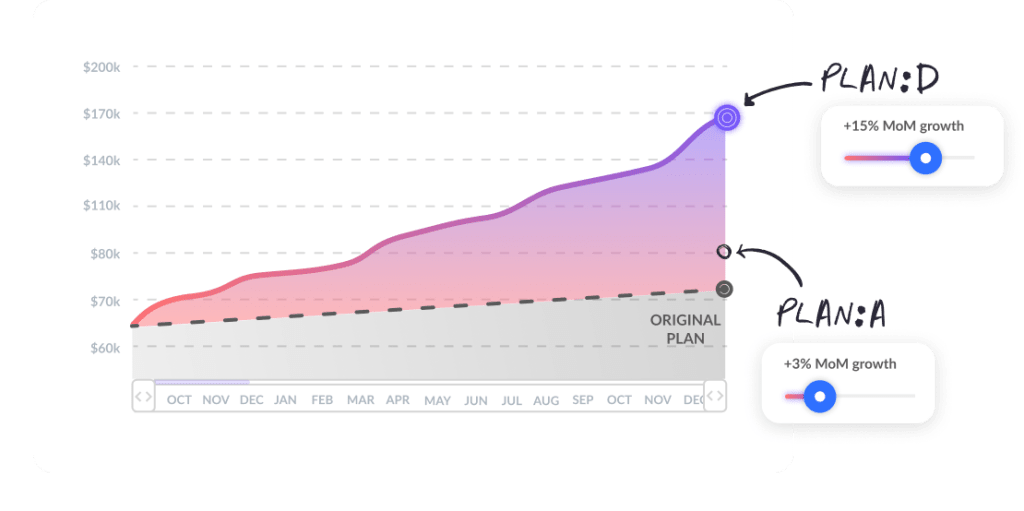
We use this feature to forecast and compare campaign ideas. This helps us confirm that our marketing goals are realistic and achievable but it can also flag up campaign ideas that might not meet our expectations. Based on these results, we can prioritise campaigns, push ahead with the ones expected to achieve the best results and reassess anything that falls short of expectations.
Another benefit of these simulations is that we can carry the results over to analysis once campaigns are live to check that they’re on course to hit targets at comparable timeframes and take action sooner if things in the wild aren’t working out as the simulations projected.
Section #10: Set your marketing budgets
Marcus recently published his ultimate marketing plan on the Venture Harbour blog, where he runs through each stage of the creative planning process. On the subject of marketing budgets, he explains that there are generally two ways businesses determine how much to spend:
- Benchmark budgets: Where businesses set aside a fixed percentage of revenue (e.g.: 7-15%) as their marketing budget.
- Goal-based budgets: Where your marketing goals, devise a workable strategy for achieving them and assign the necessary budget to make it happen.
As Marcus explains in his guide, the second of these approaches is by far the most effective method of setting budgets and getting the best results. To illustrate why this is the case, let’s take a closer look at these two approaches to setting budgets.
Method #1: Using benchmarks to set your marketing budget
Read any generic advice on setting budgets and you’ll often hear arbitrary figures for how much you should dedicate to marketing activities. Generally, these figures will be anywhere between 12-20% of total revenue for newer companies that want to grow and somewhere in the 5-15% for more established organisations looking to maintain growth.
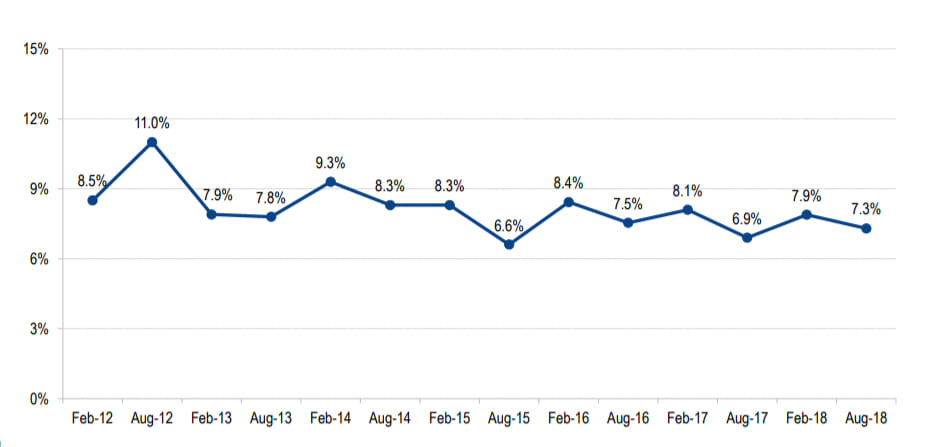
According to The CMO Survey: Fall 2018 report, the average marketing spend is 7.3% of company revenue, which gives us a rough idea of pre-Covid budgets.
However, the previous year’s report showed how much this average figure varies across different industries, even when the average across all industries was a similar 7.5%.
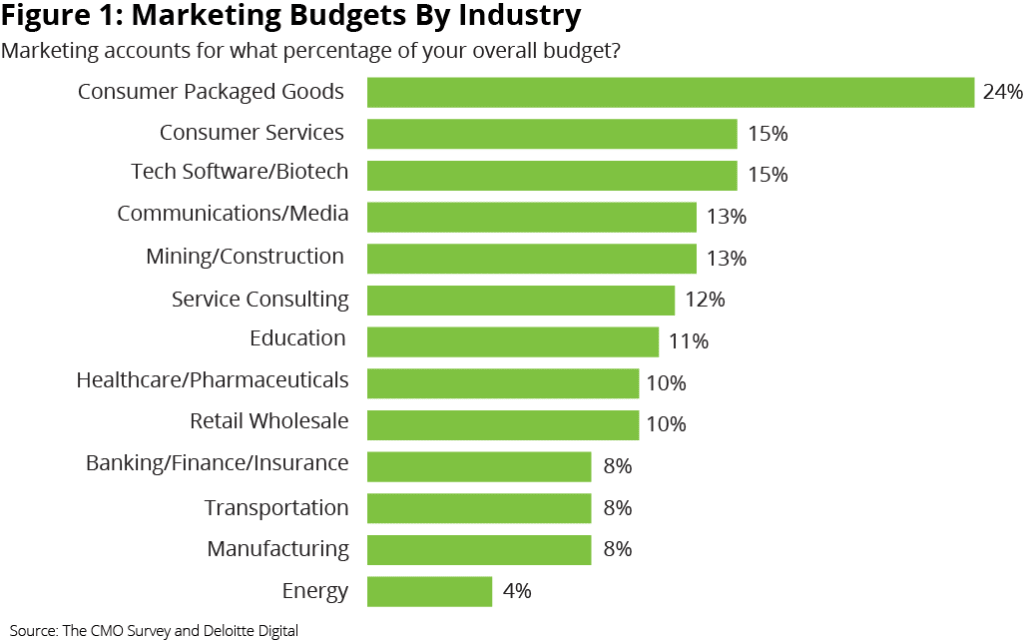
All you have to do is look at industry variance to see how arbitrary averages can lead you astray.
Going back to Marcus’ ultimate marketing plan, he explains that while this benchmarked approach is simple and easy to control, it can leave you in a vulnerable position.
“The problem is that it’s not based on achieving an objective. Spending 12% of revenue on marketing every month may seem reasonable, but it may only be enough to keep up with your competitors if they’re also doing the same. It may even lead to losing market share, especially if your competitors are using the following approach.”
Marcus Taylor, Venture Harbour CEO
While it’s important that you don’t spend beyond your means, it’s equally as important that you don’t underspend on marketing and miss out on opportunities to drive growth that could secure your position in the industry for years to come.
Also, if you’re not budgeting based on marketing objectives to begin with, it’s unlikely that you’ll be assigning funds to channels, campaigns and actions based on objectives either, meaning you’ll never get the most out of your marketing spend.
You’re simply putting in average investments and getting average results in return.
Method #2: Setting budgets based on your marketing goals
Instead of setting arbitrary marketing budgets and simply keeping your business alive, it makes more sense to define specific growth targets and set your budgets based on achieving them.
Here’s the example Marcus provides in his marketing plan guide:
Let’s say the business wants to grow by $500,000 revenue in 12 months.
If each customer brings in $2,000, then you need 250 new customers. This means, your breakeven marketing budget would be $500k (acquire 250 customers @ $2k each).
If you aim for a gross profit target of 50%, then your marketing budget is $250k and you have a target acquisition cost of $1,000. From here you can work out how many leads, demos, or clicks you’ll need to acquire one customer giving you a target cost per lead, cost per click etc.
With a budget of $250k and a target acquisition cost of $1,000, you can start putting strategies together that will achieve your growth target within those means. Your next step is to calculate the expenses of each marketing action within your strategies – every blog post, ad campaign, follow-up email, etc. – to make sure that your goals are achievable within the set budget.
To calculate the acquisition cost (CPA) of marketing actions, you can use this simple formula:
CPA = Total cost of action / total conversions
Let’s say you want to calculate the CPA of leads from a paid advertising campaign to make sure the numbers add up. You have to make sure you consider all of the costs that go into running that campaign to get an accurate picture of the true expense – for example:
- $100 per month on a Google Ads campaign
- $100 per month of a Facebook Advertising campaign
- 6 hours of writing ad copy at $80 per hour
- 6 hours designing a landing page at $60 per hour
- 2 hours designing ad visuals at $30 per hour
- 1 hour promoting content on social at $30 per hour
- 1 hour creating an automated email campaign to follow up leads at $30 per hour
Of course, these are all for the sake of example but the point is that you have to get an accurate figure of your marketing expenses to set and allocate your budget effectively.
In our example, the cost of this campaign for the first month is $1,013, including the monthly ad spend and the one-off expenses for creating the campaign. So even capturing just one lead in the first month would put us in line with our target $1,000 CPA before our monthly spend drops to $200, at which point we need to start factoring for optimisation expenses.
We can then use CPAs and total as KPIs for this campaign to ensure that performance is on track. If we’re capturing leads for less than our target CPA, we can increase bids to capitalise on the success of this campaign. If we’re overspending, we pause our spend and use it for marketing actions that are achieving better results.
Section #11: Optimising campaigns & adapting your strategies
With your campaigns up and running, it’s time to turn your attention to optimising campaigns to maximise performance and adapting your strategies to achieve the best results across each key channel.
Track performance vs your projections
Earlier, we looked at how you can use TrueNorth to predict the impact of campaign strategies before launching them. At that point, our aim was to approve and prioritise campaign ideas but, now, you can use these projections to determine where campaign performance is on course to achieve your marketing goals and where campaigns are falling short.
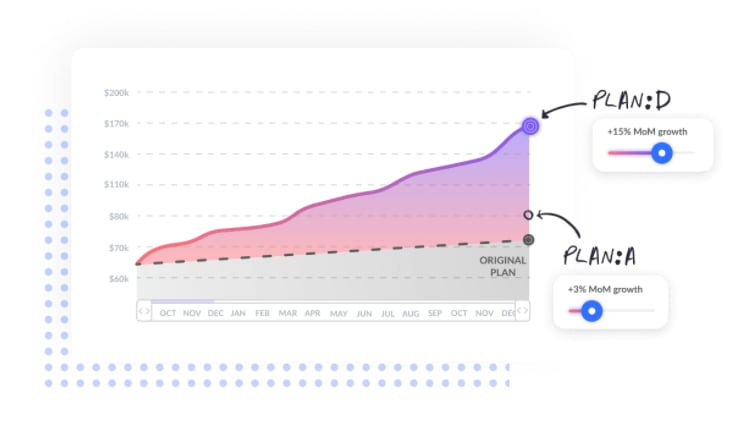
For example, if you know that Campaign A needs to generate 100,000+ unique visitors every month and convert 2.5% of those visitors to the value of $125/month, in order to hit your $3,750,000 annual revenue target, you have all of the necessary objectives to optimise this campaign.
As soon as traffic levels drop below your 100,000/month target, you know that your prospects of hitting 2.5% conversions worth $125+/month are going to suffer and this points you in the direction of where to optimise: generating more traffic.
Likewise, if you’re not converting 2.5% of visitors into customers paying $125/monththen you have to explore strategies for increasing this conversion rate or increasing the average value of your conversions.
By setting clear, achievable goals – as we discussed earlier – forecasting results and setting clear objective targets, you can analyse campaign performance at a granular level and diagnose any performance issues with greater accuracy.

Taking this beyond the campaign level, you can apply the same performance tracking across your entire funnel. You may find some campaigns are performing better than expected, for example, which could make up or exceed the underperformance of others.
Whatever the situation looks like, you can see how individual campaigns are contributing to your primary marketing and business goals while TrueNorth’s simulator tools help you spot opportunities to improve performance.
Optimise underperforming campaigns
If you follow the steps we outlined in the previous section (and throughout this guide), you shouldn’t have any problems with identifying underperforming campaigns and, more importantly, which specific KPIs or metrics are suffering – e.g.: traffic, volume, conversion rates, conversion value, etc.
So you’re not simply looking at a campaign and thinking, how can we fix this? You know exactly what problem you’re trying to solve (for example, increasing CTRs or reducing bounce rates) and you can test calculated fixes with a higher chance of achieving your desired outcome.
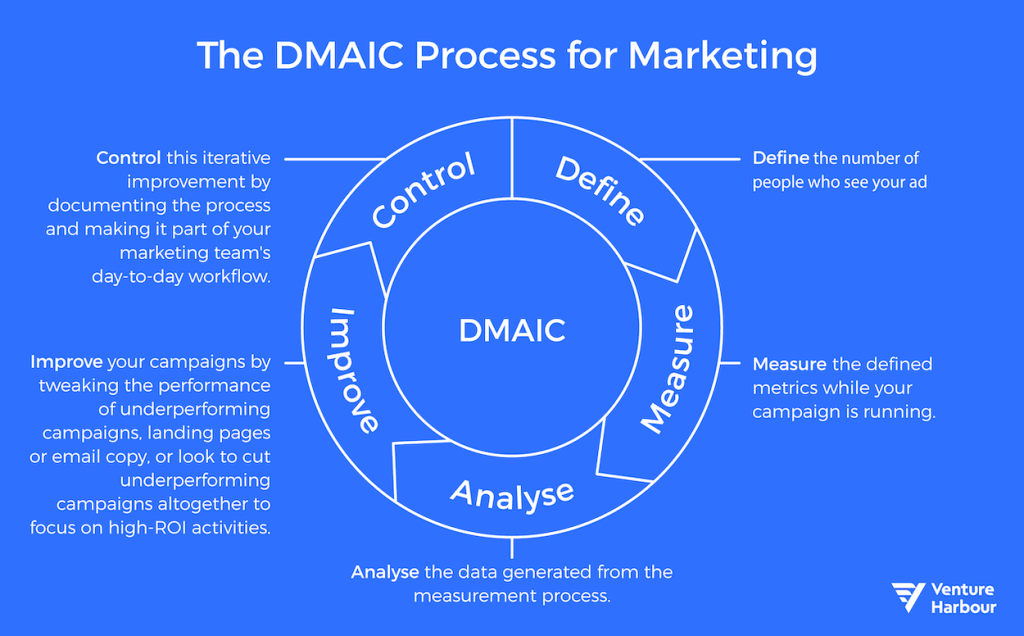
Like everything we’ve discussed in this guide, you can determine which experiments to run based on your marketing goals and the KPIs that you’re looking to optimise.
Here are some examples of how you can narrow down experiment ideas:
- Traffic: Optimise bids, increase impressions, improve your targeting strategies, find new keyword opportunities and get your brand/offer seen by the right people.
- CTRs: Test different ad formats, content ideas, headlines, copy, CTAs etc. to incentivise more clicks.
- Bounce rates: Decrease loading times, increase the relevancy of your messages, target niche audiences and improve the overall user experience.
- Conversion rates: Optimise landing pages, copy, CTAs and offers to hammer home the message and turn interest into buyers.
- Conversion value: Optimise CTAs, pain points, pricing pages, offers, upselling campaigns etc.
- Retention rates: Incentivise customer loyalty campaigns, rewards, cross-selling campaigns, etc.
- Customer value: Cross-selling, up-selling, customer service, customer retention, referral programmes, etc.
Of course, these are quite broad experimentation ideas and drill down even further to identify key elements of campaigns/pages to optimise, such as optimising your web forms to increase completion rates or improving the performance of your mobile landing pages specifically.
The key is to keep following your data, starting from your marketing goals and the KPIs defined for each strategy, which allows you to pinpoint the campaign and page elements that’ll have the biggest impact on performance.
Increase budgets for top performers
Improving the results of underperforming campaigns is generally your priority when it comes to optimising performance but you also need to keep an eye out for channels, strategies and campaigns that are achieving the best results.
You want to invest more budget into your most profitable marketing actions while you focus on testing those that aren’t up to par.
As Jonathan Gordon writes for McKinsey, “with budgets under increasing pressure, marketers must allocate every dollar with precision and purpose.”
“What companies need is an analytical, forward-looking approach that allocates marketing dollars to customer segments as well as products or geographies that have the highest growth potential rather than to those that have traditionally performed well.”
Your marketing budget isn’t a set-it-and-forget-it entity, as long as you have the data required to measure performance, model future trends and adapt your spend accordingly, which is the approach we’ve taken throughout this guide to marketing strategy.
Give every campaign the best possible start
The key takeaway from this guide is that your marketing goals and objectives should determine every aspect of your marketing strategy – from the early creative stages through to the execution and optimisation processes.
Now, it’s your turn to define clear, achievable goals for your next campaign and determine which measurements represent performance most accurately so that you can tweak resources, elements and campaign settings to maximise results based on the goals and KPIs you identify ahead of launch.




